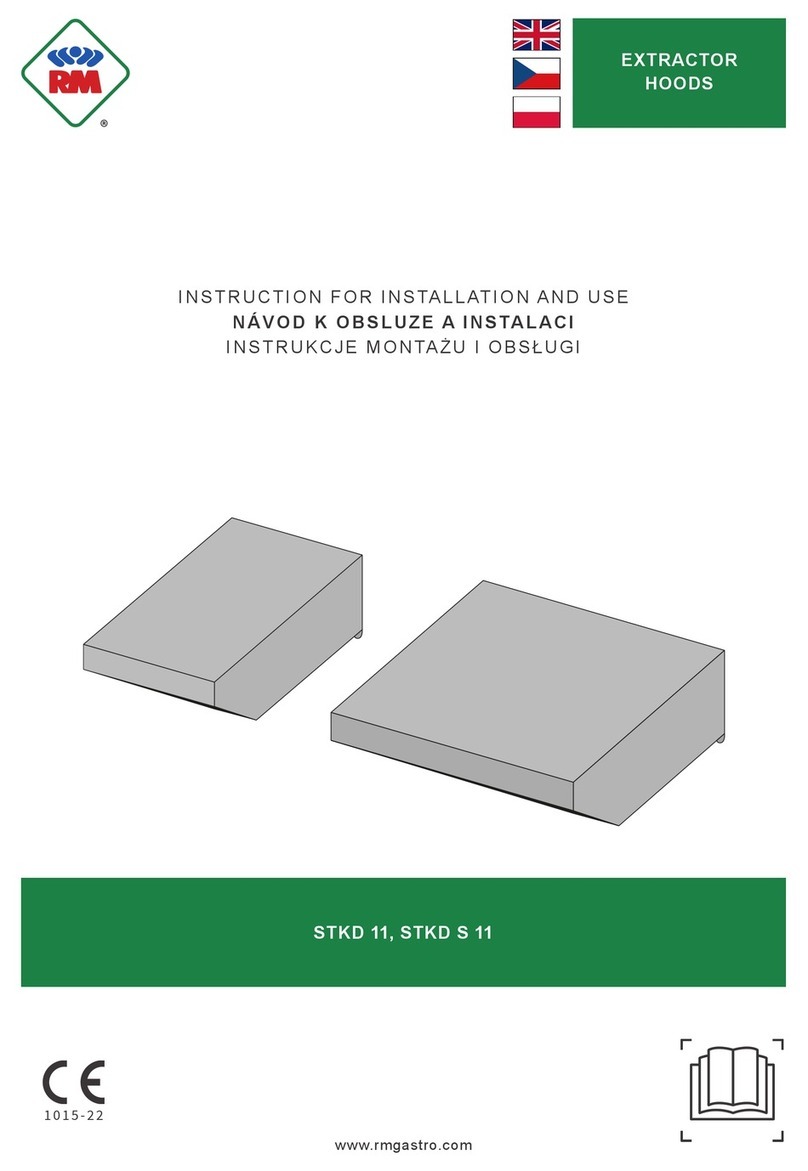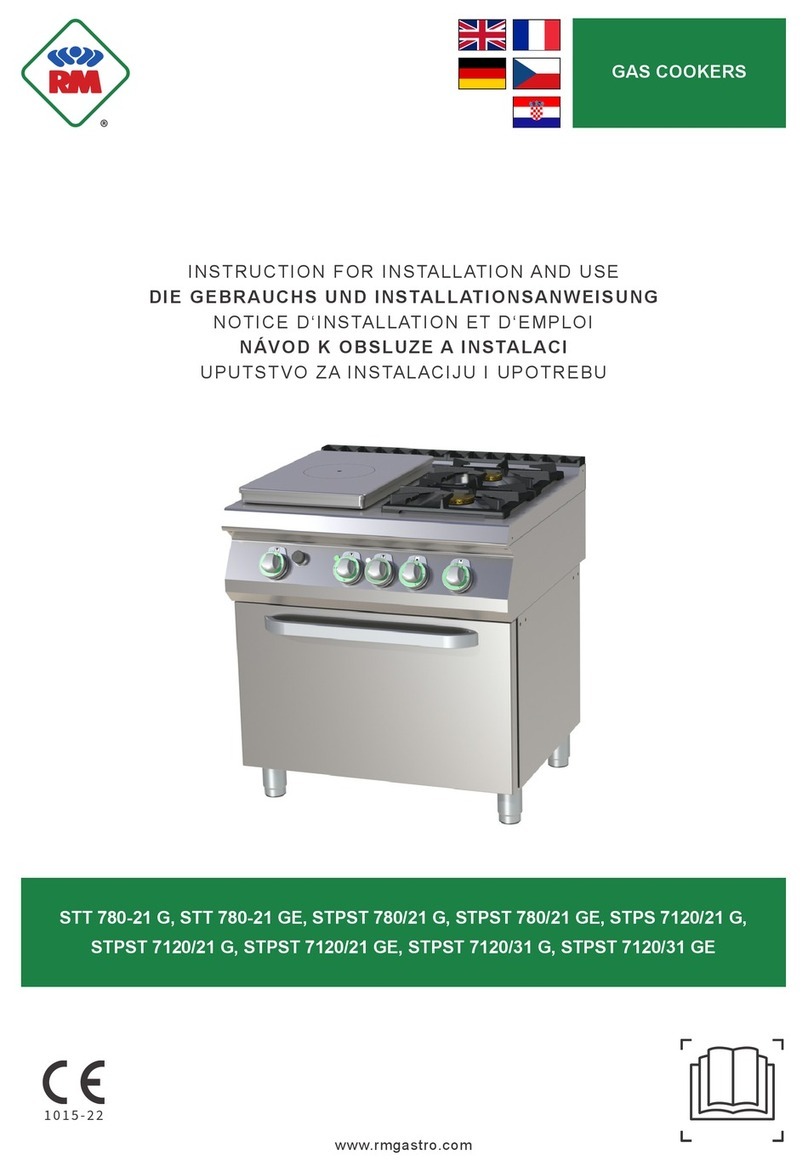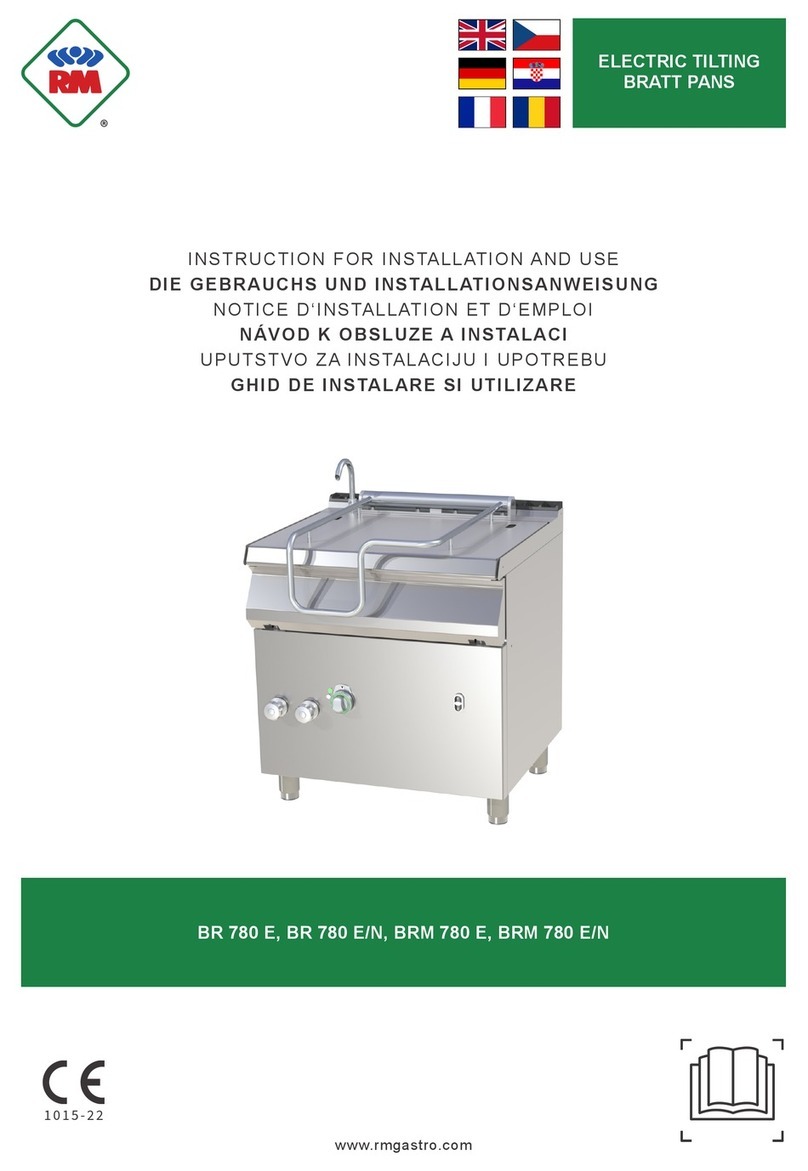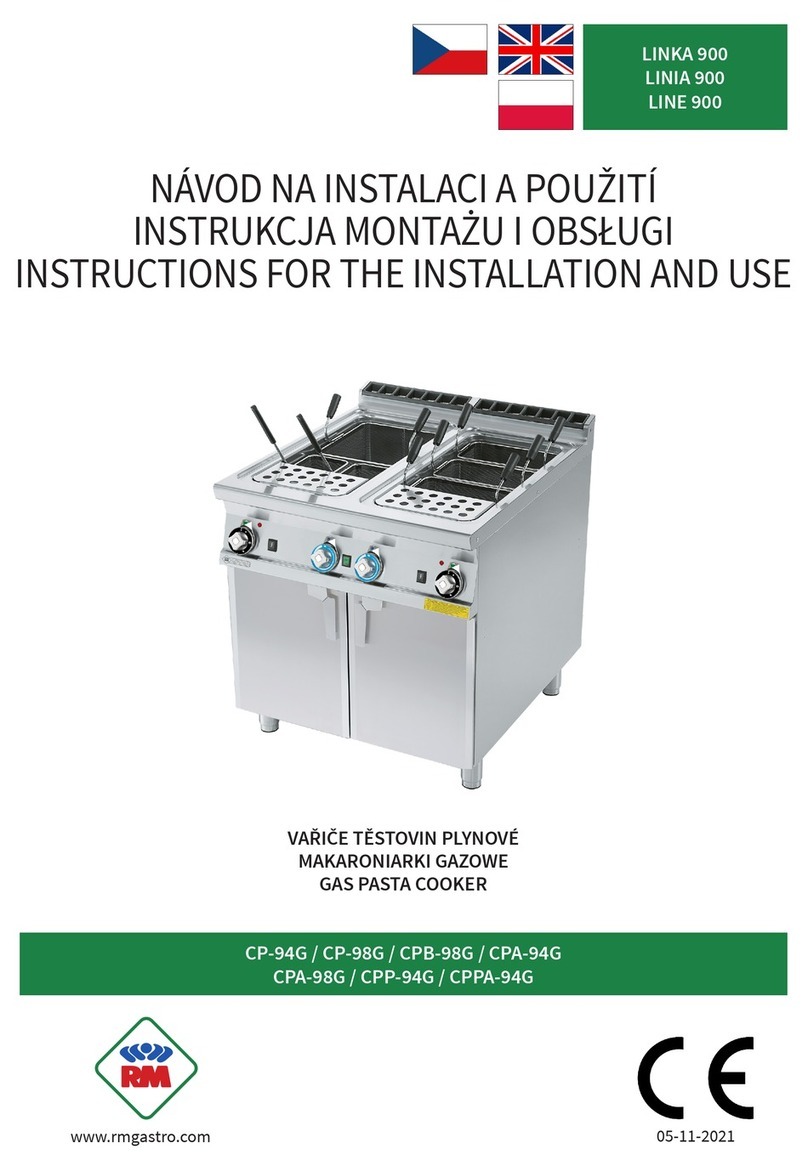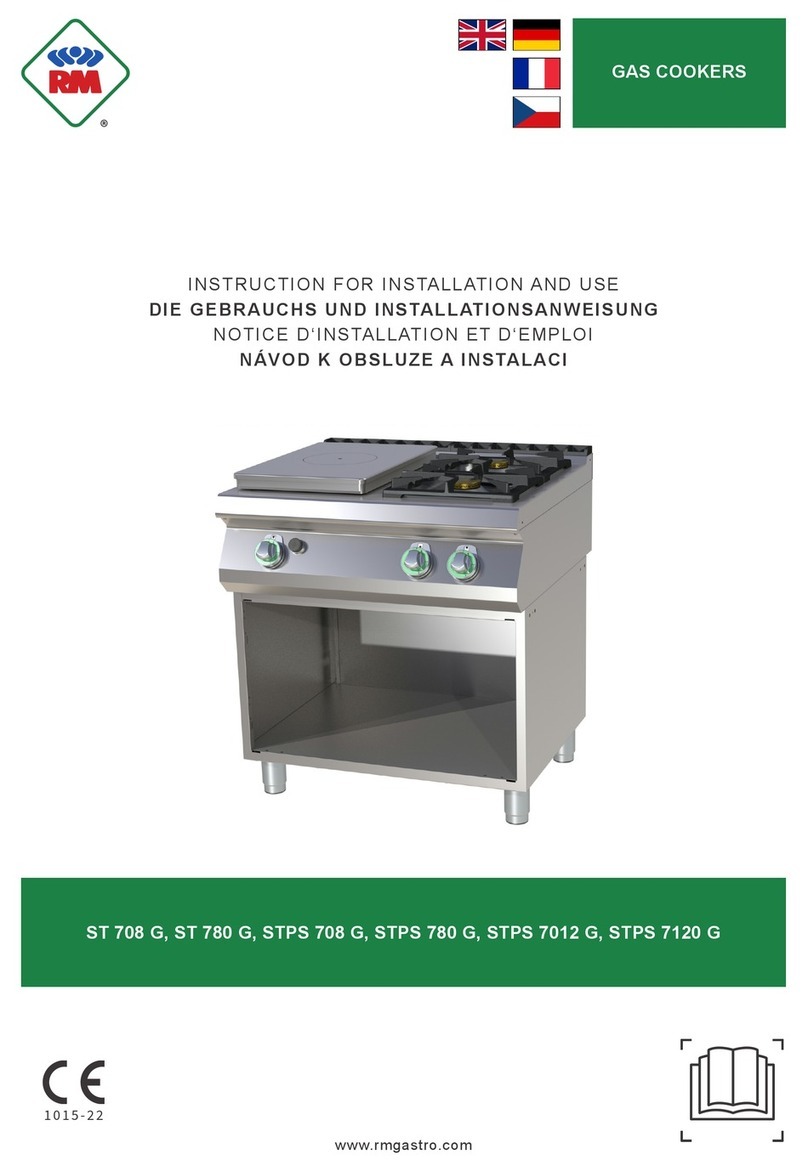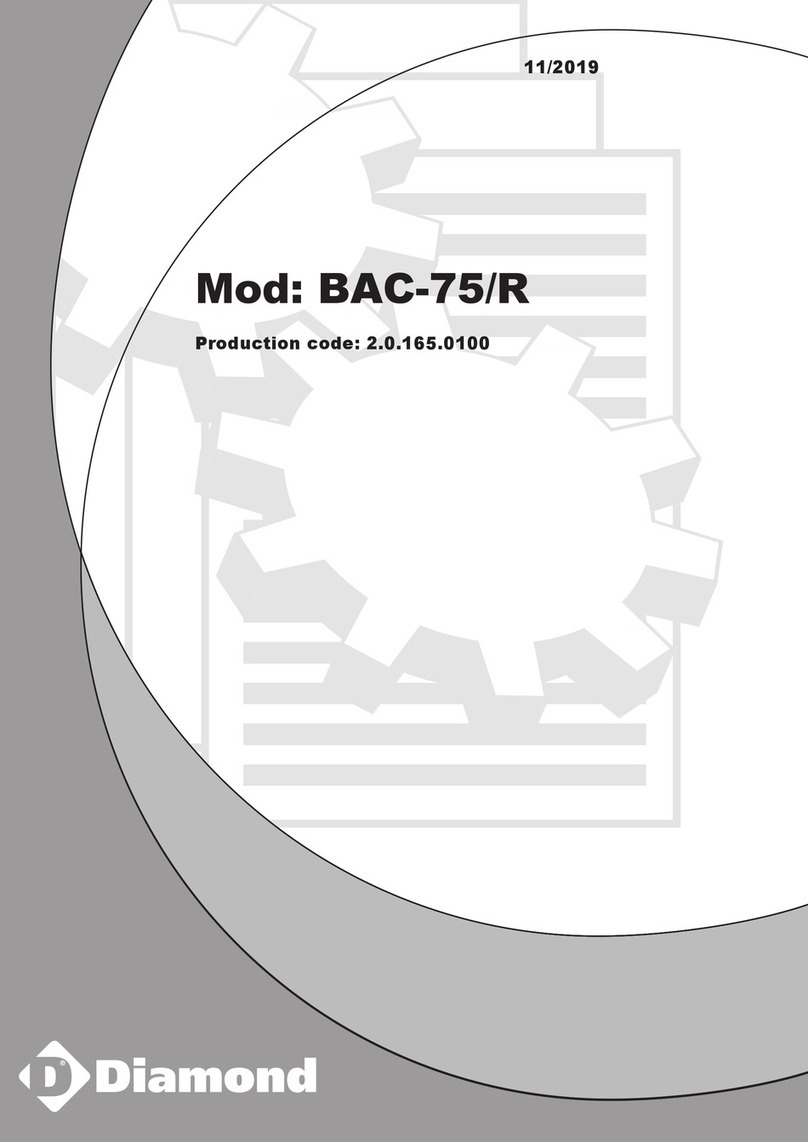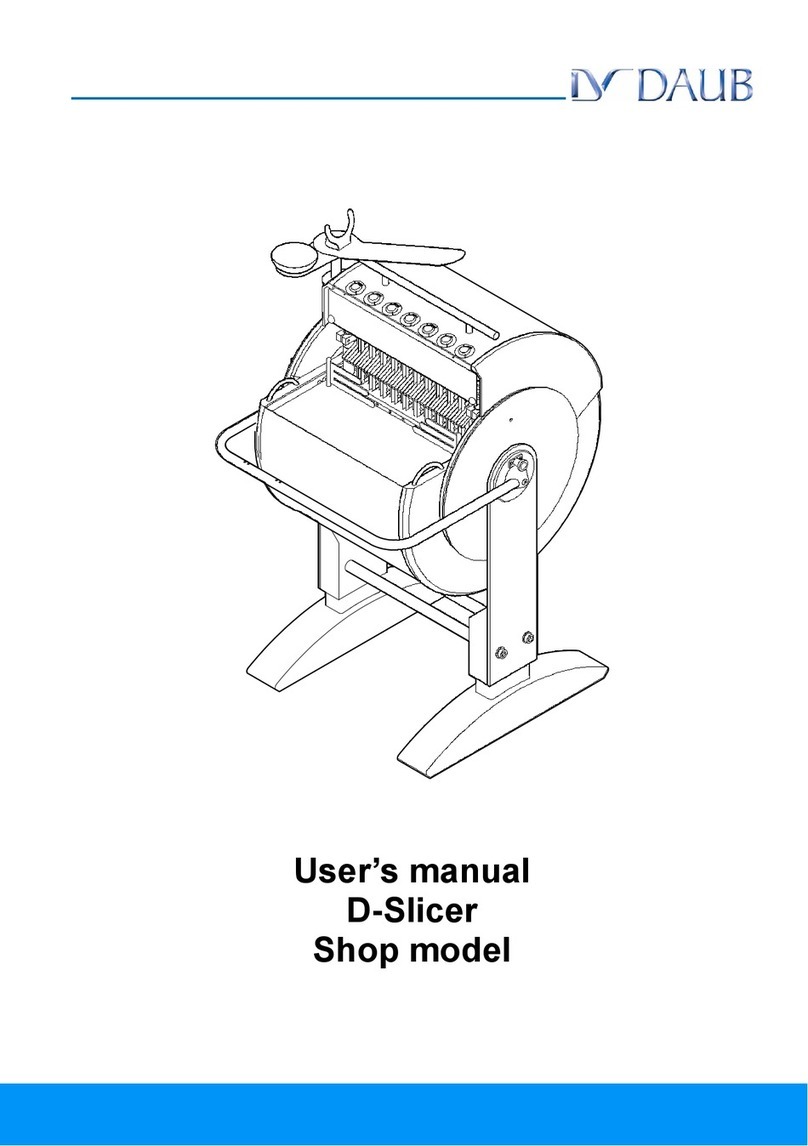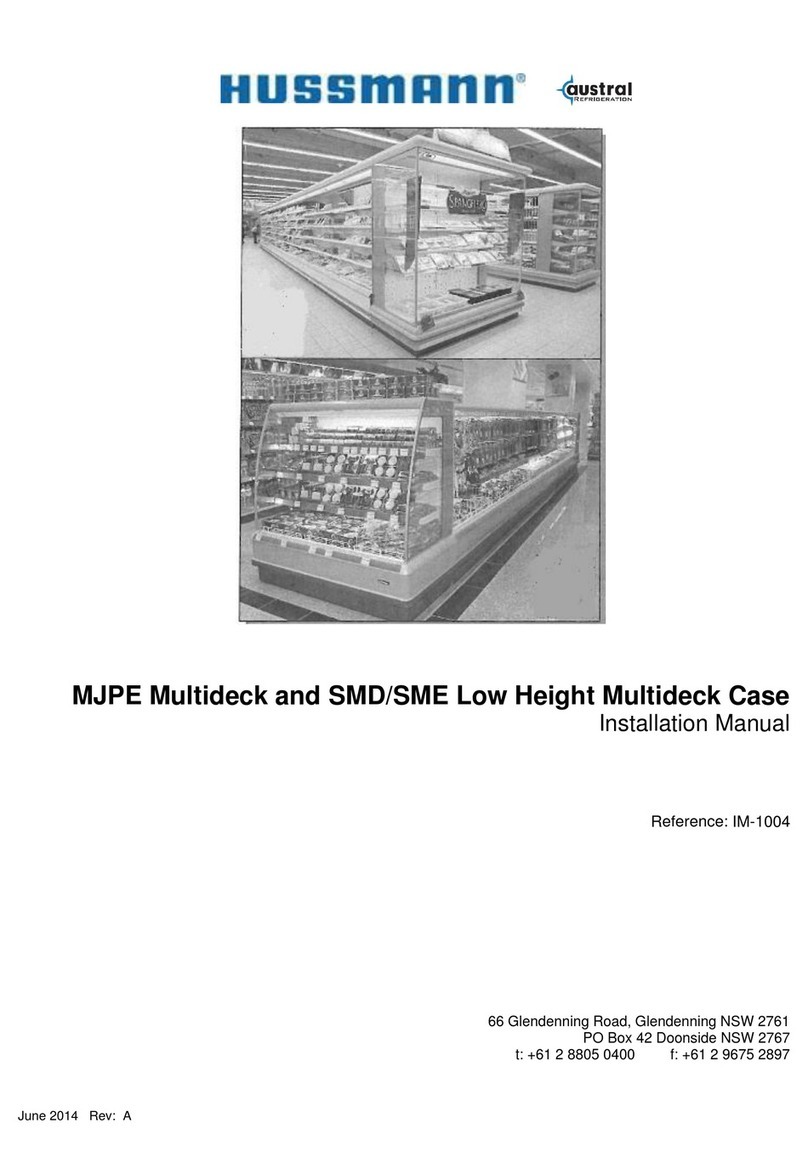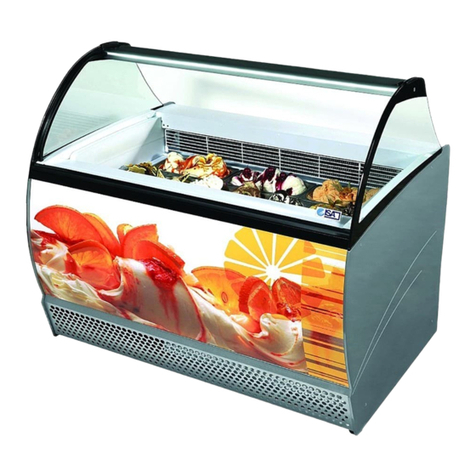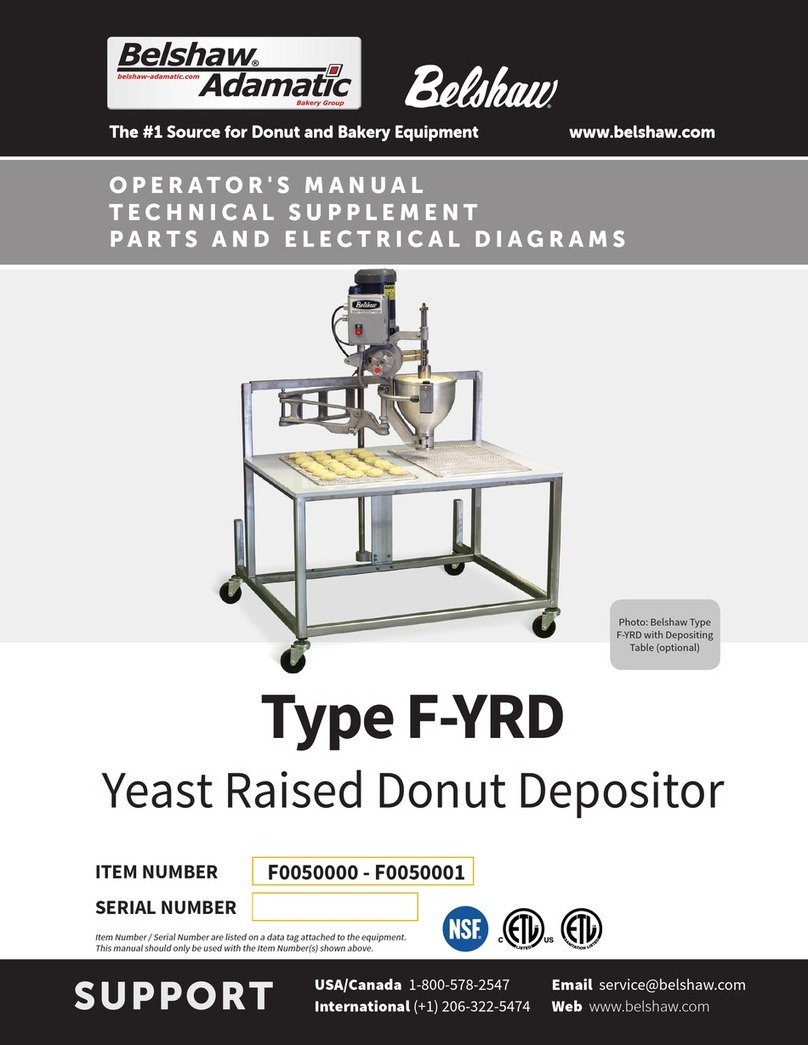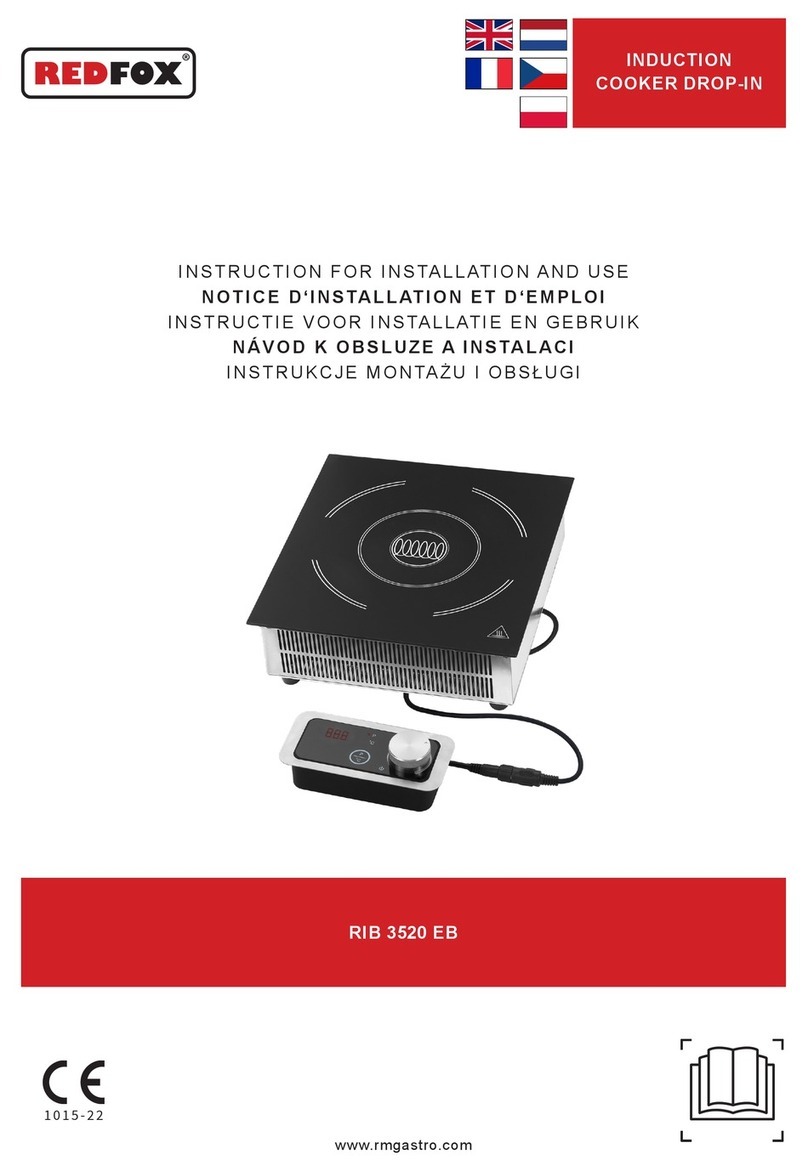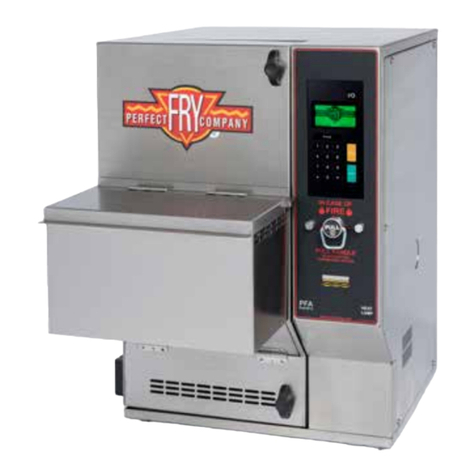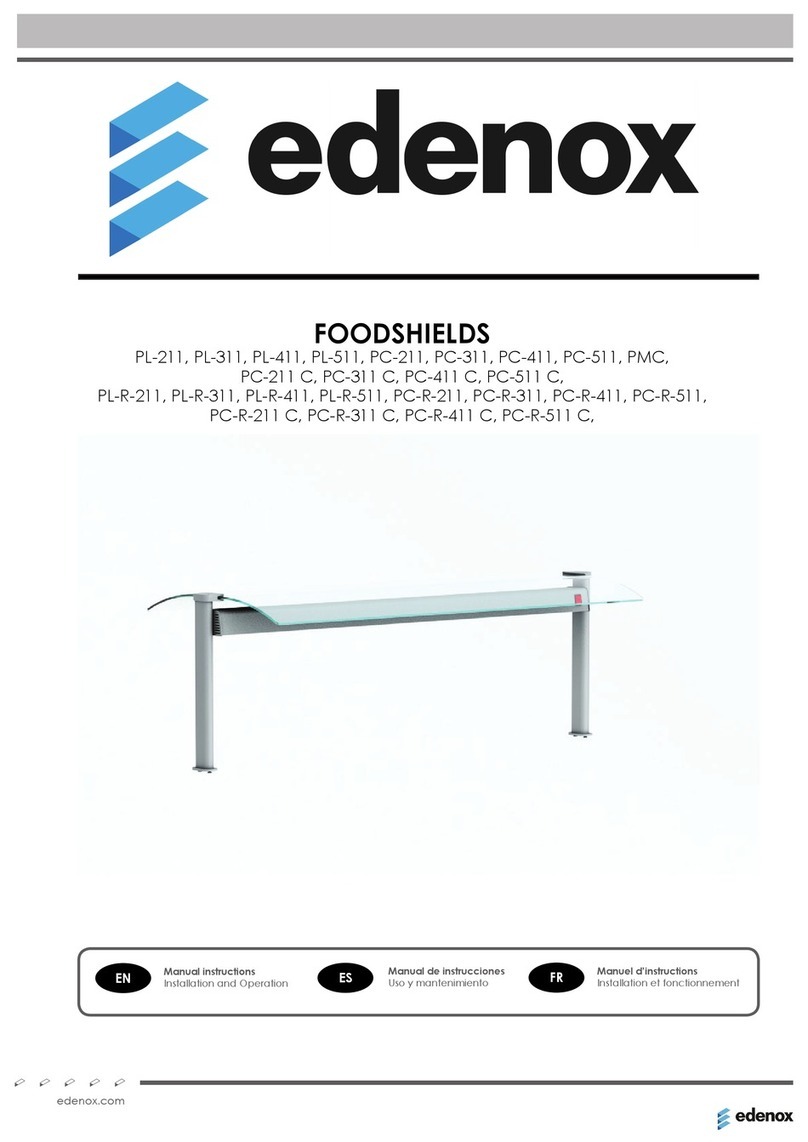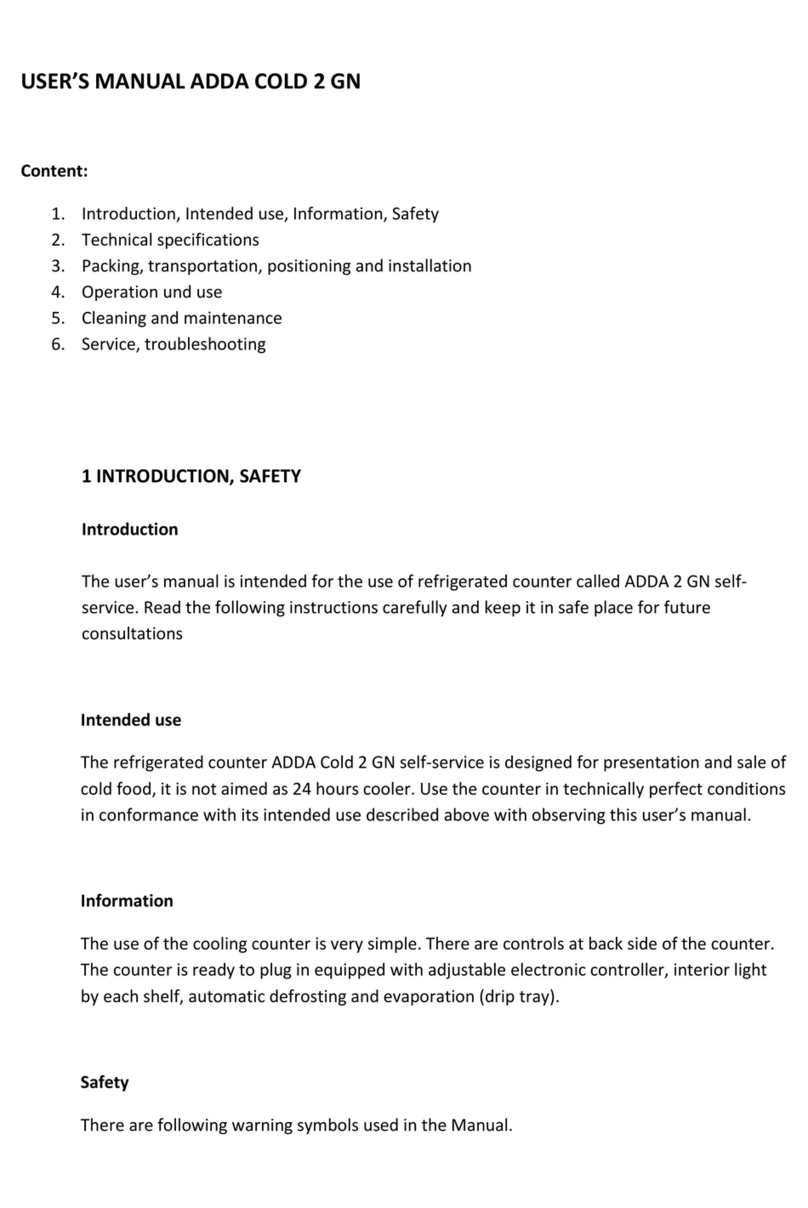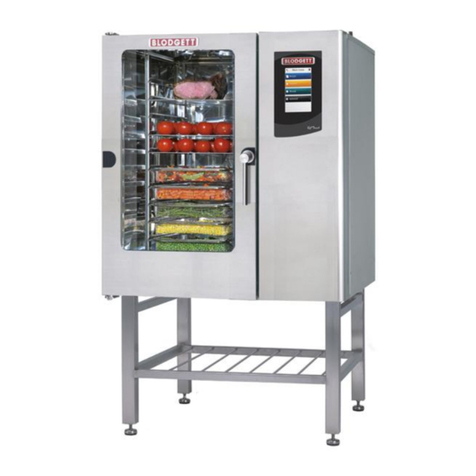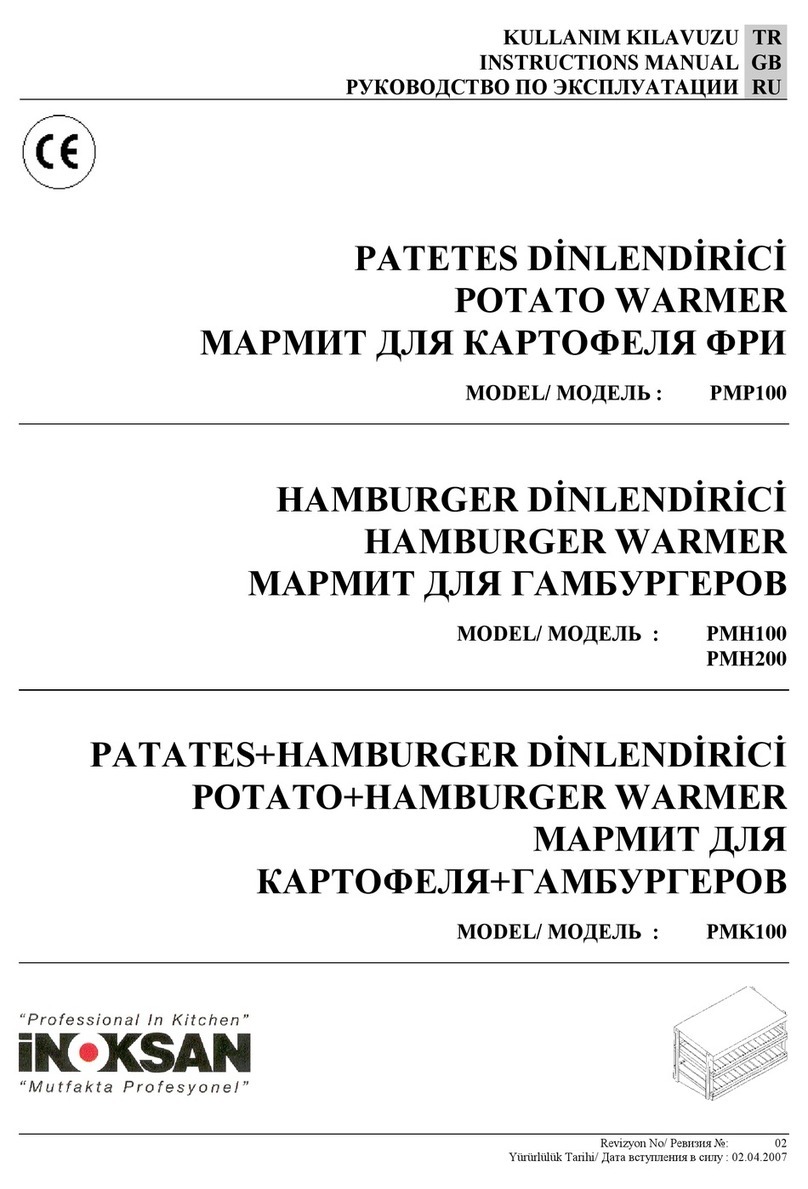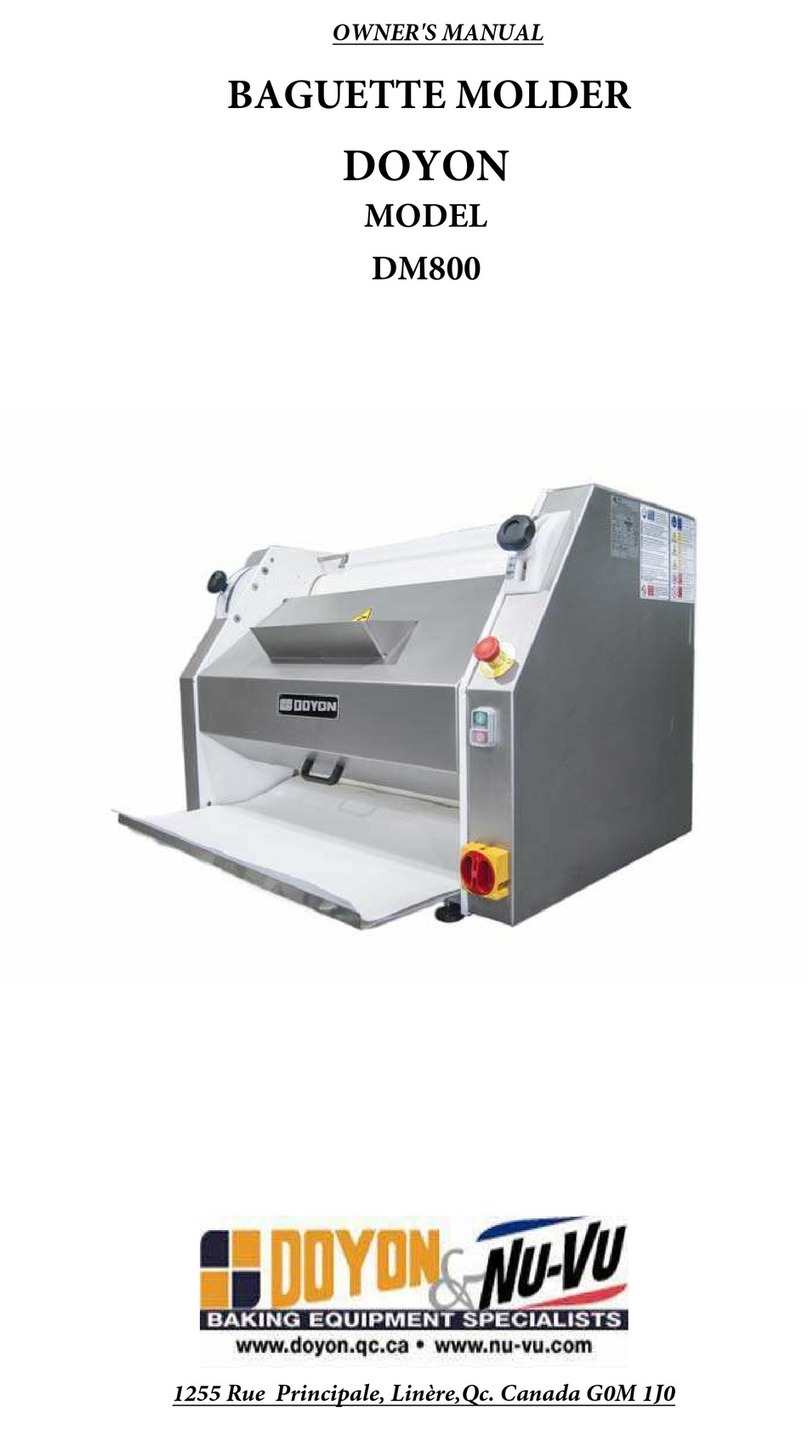RM BR 780 G User manual

GAS TILTING
BRATT PANS
1015-22
BR 780 G, BR 780 G/N, BRM 780 G, BRM 780 G/N
www.rmgastro.com
INSTRUCTION FOR INSTALLATION AND USE
DIE GEBRAUCHS UND INSTALLATIONSANWEISUNG
NOTICE D‘INSTALLATION ET D‘EMPLOI
NÁVOD K OBSLUZE A INSTALACI
UPUTSTVO ZA INSTALACIJU I UPOTREBU
GHID DE INSTALARE SI UTILIZARE

2023-04-17
CONTENT
Declaration of a standards conformity
Instruction for use
Cleaning and maintenance
3
9
11
INHALT
Die Normenübereinstimmungsdeklaration
Gebrauchsanweisung
Die Reinigung und instandshaltung
12
19
21
CONTENU
Déclaration de conformité
Mode d‘emploi
Nettoyage et entretien
22
29
31
OBSAH
Prohlášení o souladu s normami
Návod k použití
Čistění a údržba
38
47
49
SADRŽAJ
Izjava o saglasnosti Sa normama
Uputstvo za upotrebu
Čišćenje i održavanje
56
64
66
CONŢINUT
Declarație de conformitate cu regulile
Ghid de utilizare
Curățare si mentenanță
71
78
80

Type of product Bath tilting Material of
bath bottom Volume (l) Power
(kW)
Dimensions
(cm)
BR 780 G manual Fe 50 12 80x73x90 v
BR 780 G/N manual INOX 50 12 80x73x90 v
BRM 780 G electric Fe 50 12 80x73x90 v
BRM 780 G/N electric INOX 50 12 80x73x90 v
9,45 kWh/m3
G20
NATURAL GAS
(20,25)mbar
8,12 kWh/m3
G25
NATURAL GAS
(20,25)mbar
12,68 kWh/kg
G30
BUTAN
(30)mbar
12,87 kWh/kg
G31
PROPAN
37mbar
Nozzle of main burner
1/100mm 310 310 175 165
Nozzle of pilot burner
1/100mm 51 51 30 30
Nozzle overpressure - full
power (mbar) 9 13,5 26 26
Air control setting (mm) 11 11 10 10
Gas consumption 1,27 1,477 0,946 0,932
3

Outlet hood with natural extraction (A). Flue gas provides a natural chimney draft.
Outlet hood without natural extraction. Flue gas is secured by a fan (D) (forced extraction). In this
case, it is necessary to secure the connection with a gas feeder (B) to turn off the gas supply in case
of failure.
NATURAL EXTRACTION FORCED EXTRACTION
CHIMNEY DESIGN FOR AN APPLIANCE –TYPE A
PACKING AND DEVICE CHECK
The device leaves our stocks properly packed with appropriate symbols and labels. There are also appropriate
instructions for use. In case the packing shows bad handling or damage, it must be reclaimed at transporter
immediately by writing and signing of a damage protocol.
Important notice:
-This product is only intended for use inside.
Never use the appliance if it has a damaged supply cable or plug, if it is not working correctly, has fallen to
the ground and been damaged or fallen into water. In such cases take the appliance to a professional service
in order to verify that it is safe and works correctly.
• only for proffesional use
• this instructing guide must be read properly and carefully because it contains important information about
safety elements, installation, use
• these recommendations refer to this product
• this product corresponds with valid standards
• this guide must be properly deposited for future use
• keep the children away from manipulation with the product
• when selling or moving the product to another place it is necessary top make yourself sure that the staff
or the professional service has got acquainted with control and installation instructions from enclosed guide
• only authorised person can operate the product
• it can not be switched on without supervision
• we recommend to have the product checked by professional service min. once a year
• only original spare parts can be used for repairs
• the product can not be cleaned by the water jet or pressure shower
• by damage or break down disconnect all the feeders (water, gas, electricity) and call professional service
• producer refuses any responsibility in case of damages caused by wrong installation, by disobserving of
above mentioned recommendations or by other use etc.
4

TECHNICAL INSTRUCTIONS FOR INSTALATION AND REGULATION
Important:
The manufacturer does not provide warranty for defects caused by improper use, failure to instructions
contained in the attached instructions for use and mistreatment of the appliances.
Installation, adjustment and repair of appliances for kitchens, as well as their removal because of possible
damage to the gas can be carried out only under a maintenance contract, this contract may be signed with an
authorized dealer, and must be complied with regulations and technical standards and regulations regarding
the installation, power supply, gas connection and health & safety system.
These instructions are intended for the qualifi ed technician who must perform the installation, put it into
operation and test the appliance.
Any activity as settings, placement, rebalancing etc, must be made only when is device disconnected from
electricity. If it is necessary to have the device connected to the electricity you must keep the highest attention
to avoid any injuries.
DEVICE INSTALATION
Instalation, setting, rebuilding for another gas type, putting into operation must be done by qualifi ed person
whois competent for this and according to the valid standards. The device can be instalated in good ventilated
room. When it is possible place the device under the fumehood to suck off the products of combustion. Air
needy to the burning is 2m/3/h/kW ot the performance of the instaled device. The device can be instalated
separately or in a set with devices of our production. Min. distance 10 cm from other subjects must be kept.It
is also necessary to prevent our product from contact with combustible materials. In this case you must make
corresponding changes to secure heat izolation of combustible parts (for example:place between the device
and combustible material azbestos plate).
Outlet hood with natural extraction (A). Flue gas provides a natural chimney draft.
Outlet hood without natural extraction. Flue gas is secured by a fan (D) (forced extraction). In this
case, it is necessary to secure the connection with a gas feeder (B) to turn off the gas supply in case
of failure.
NATURAL EXTRACTION FORCED EXTRACTION
CHIMNEY DESIGN FOR AN APPLIANCE –TYPE A
5

CONNECTION OF THE ELECTRIC CABLE TO THE ELECTRICITY
Instalation of electric feeder - This feeder must be separetely protected by a safety fuse according to the
specifi c electric stream which depends on the wattage of the instaled device. Check the wattage on the label
at the back of the device. Connect the device directly to the electricity but you must put the switch between
the device and electric net. The switch must be placed in min. distance 3 mm between the particular contacts
according to the standards and loading. The feeder of grounding (yellow-green) cannot be interrupted by this
switch. In every case feeding cable must be placed so that no point of the cable will reach the temperature
which is 50°C higher than the temperature of the surrounding. Before connecting the device check that:
• safety fuse of the feeder and inner mains can stand the loading of the device (see label of the matrix)
• mains are equipped with effective grounding according to standards (ČSN) and conditions given by law
• socket or switch of the feed is well accessible from device
We refuse any responsibility in case of not respecting above mentioned rules. Before the fi rst use it is
necessary to remove all the protection foil and to clean the device - see chapter „cleaning and maintenance“.
Maintenance: We recommend to have the device checked once a year by the proffesional service. Only
qualifi ed or competent persons can do interventions in the product.
-Do not insert the power cable plug into the el. socket and do not pull it out of the
el. socket with wet hands or by pulling on the cable!
-Do not use extension cables or power strips.
SAFETY MEASURES FROM THE STANDPOINT OF THE FIRE
PROTECTION ACCORDING TO EN 061008 ČL. 21
• only adults can operate the device
• device must be safely used in common surroundings according to EN 332000-4-462; EN 332000-4-42. You
must switch the gas device off under the circumstances leading: to the danger of the temporary rise of the
combustion gas or steam or during works when there is a big possibilityof rise ot the temporary fi re danger
or explosion (for example: to stick linoleum, PVC etc.).
• before you start to instal the device you must get the licence for connection to the gas feeder from the
gasworks
• device must be placed so as to stand or hang on the noncombustible surface which is on each side 10
cm larger than the device. No subjects from combustible materials can be placed directly on the device
or in distance which is shorter than safety distance (the shortestdistance is 50 cm in the direction of the
heat emission and 10 cm in other directions).- safety distances from various materials of different degree of
combustion and information about the degree of comb. of common building materials - see chart:
Chart:
Combustion degree of building materials classifi ed according to the combustion degree of materials and
products (EN 730823)
A noncombustible granit, sandstone, concretes,bricks, ceramic wallfacing tiles, plaster
B uneasily combustible akumine, heraklite, lihnos, itavere
C1 hardly combustible leafy wood, plywood, sirkoklit, rare paper formica
C2 middle combustible fi breboards, solodure, cork boards, rubber,fl oor-coverings
C3 easily combustible wood-fi breboards, polystyrene,polyurethane, PVC
Devices must be instalated in a safe way. When instaling you must respect corresponding project, safety and
hygienic orders according to:
• EN 061008 fi re protection of local devices and sources of heat
• EN 332000 (33 2000-4-482; 33 2000-4-42) surrounding for electric devices ČSN EN 1775 Gas supplying
• Gas fi ttings in the buildings - the highest operational pressure < 5 bar - operation demands
• § 10 law nr. 185/2001 Sb. about waste
6

WATER CONNECTION
Water connection is performed with hose threaded G1/2. The water supply must be equipped with a separate
valve which is freely available and within range of the device. The equipment includes a check valve.
• Water hardness must be in range 0,5 - 5 ° French degree.
IF HIGHER, IT IS NECESSARY USE WATER SOFTENING SYSTEM.
• Water pressure must be within range 50 - 250kPa.
• Volume of chlorine in the water shall not be higher than 10ppm, or you risk bath surface damage
• Acidity of water must be higher than 7 pH.
• Electrical conductivity: 50 - 2000uS/cm (20°C)
• The connection must be made according to directive EN 1717 and with valid to national directives for aqua-
culture.
PIPE FOR GAS CONNECTION
It must fi rst determine if the appliance is made for the same type of gas that will be used and thus conforms
to the indications on the label the type of gas to be used.
The conversion of gas pan to another type of gas you need to check if it corresponds to the type of gas
bearing, which is recommended in this guide.
Connecting the appliance to the gas distribution must be towable to a steel or copper tube complying with
applicable national requirements. This must be controlled on regular basis and changed if needed. Every
appliance must be equipped with shut-off valve and quick shut-off valve. Quick shut-off valve must be freely
accessible and within reach of the device. After installation, is necessary to check whether there is a gas leak.
To fi nd a gas leak you can use soapy water or spray for gas leak detection.
Do not use corrosive substances!! All our appliances are carefully controlled. Gas type, pressure and of the
categories listed named on the technical information plate.
Liquid gas connection:
Pressure for liquid gas connection must be 28 or 30 mbar for propane/butane and 37 mbar for propane. It
is necessary to check the technical label ,gauge the pressure and check the parameters of the nozzle is
installed with the required parameters of the nozzle according to the manufacturer‘s. If the pressure is lower
than 25mbar or higher than 37 mbar, THE APPLIANCE SHALL NOT TO BE CONNECTED.
Gas Connection:
Pressure for methane connection must be 18 or 20 mbar. It is necessary to check the technical label ,gauge
the pressure and check the parameters of the nozzle is installed with the required parameters of the nozzle
according to the manufacturer‘s. If the gas pressure is lower than 15mbar or higher than 22,5 mbar, THE
APPLIANCE SHALL NOT TO BE CONNECTED.
7

MEASURES FOR THE REBUILDING AND INSTALLING A DIFFERENT TYPE
OF GAS
Our appliances are certifi ed and regulated the natural gas (see technical plate). Conversion or
adaptation to a different type of gas must be performed by authorized personnel. Nozzles for diffe-
rent types of gas are in a bag provided with the pan and are marked in hundredths of mm (table of
technical data pipes).
Nozzle replacement:
For nozzle replacement, front panel must be removed. After release M5 bolt insert air regulation
(Fig. 3, note 2), with wrench no.13 unscrew original nozzle (Fig.3, note 3) and screw back new no-
zzle. Then is necessary set new value for air regulation (Fig.3, dimension “A”). Dimensions for gas
are shown is table of technical specifi cations for burners. Also is necessary get change nozzle of
pilot burner (Fig.4, note 5).
With wrench no.10 you need disassembly pipe for pilot burner and eject out. The nozzle is located
among last part of the pipe and pilot burner.
After the exchange and re-mounting supply pipes, it is necessary to check out the sealing of conne-
ctions.
Pressure adjustment:
Pressure is measured with a manometer with the required sensitivity. Connect manometer after
unscrewing air sealed bolt into required location (Fig.5, note 8). Pressure adjustment screw is acce-
ssible after removing the cap (Fig.5, note 5). The pressure is set to the value given in the table of
technical data burner (page 10). After the measurement is necessary to screw the bolt back and
check the sealing.
Important:
After what was done adjusting the appliance to another type of gas, it is necessary to change the
gas indicated on the technical plate located in a visible location on the side of the device.
Commissioning and device check
• After connecting the device on the gas, water and electricity, the entire installation and operation
of the device must be tested
• Particularly check the following: - Check that all connections have been made by the installation
instructions presented - Check that are observed and complied with all applicable standards and
health & safety regulations and legislation and guidelines - Check appliance for gas leak - Check
tightness of inlet water - Check ignition burners - Check the stability of the fl ame - In case of change
of equipment to another type of gas modify the identifi cation gas tag which is located below the gas
inlet.
8

INSTRUCTION FOR USE
Attention!
Before the fi rst use of the appliance you must remove protection foil, wash the device and bath with
water containing washing liquid and then dry with the cleaning cloth. Into the bottom of the bath
spread a vegetable oil and begin burning procedure by 230°of Celsius. Before you start cooking, it
is necessary make this burning procedure. The optimum is about 3–5 days use appliance as frying
pan, and then for cooking. If pans washing was done by chemical substances, we recommend to
use about 4-6 cycles as frying pan before you start cooking in it again. The device cannot be used
under any circumstances as a fryer or its substitute
Ignition the main burner:
With lighter:
Slide the door on the left front panel and turn gas valve control knob to the ignition position (Fig.2,
note 3 and Fig.6) and keep it pressed. Press the piezo lighter button couple of times. After burner
ignition, keep this button pressed for few second (about 10-20 sec.) until is the thermo fuse warmed
up, then release button. If the fl ame goes out, repeat the whole procedure again.
With electric burning:
Slide the door on the left front panel and turn gas valve control knob to the ignition position (Fig.2,
note 3 and Fig.6) and keep it pressed. Flame will ignite automatically. After burner ignition, keep this
button pressed for few second (about 10-20 sec.) until is the thermo fuse warmed up, then release
button. If the fl ame goes out, repeat the whole procedure again.
Ignition of the main burner and thermo regulation
Turn gas valve control knob to the ignition position (Fig.6) and set button of thermostat to required
temperature. Main burner will ignite.
Switching off of the main burner
The main burner is possible switch off with turning thermostat button to “0”position, or turning the
gas valve control knob to ignition position. Main burner will go out, but pilot burner keeps working.
Switching off the whole device
Set the gas valve control knob to position off. At this moment all burners goes out.
Filling water to the bath
Open valve for water fi lling and when achieve required volume of the water, simply close it. Water
fi lls up only when the lid of the bath is open.
Draining of the bath
Tilt the bath to required position for her drain with help of the manipulation handle. Attention! Before
you start draining of the bath, attach under overfl ow suitable container. Keep maximum attention if
you will be manipulating with boiling content. After successful bath draining, return it back to opera-
tion position.
ATTENTION!
When tilting the bath, main burner goes out, but automatically starting when returning bath into ope-
ration position. Because of this, make sure before you start draining of the bath, that main burner is
switched off.
9

CLEANING
ATTENTION!
The device cannot be cleaned by direct or pressure water. Clean it daily. Daily maintenance keeps longer
useful life and effi ciency of the device. Before cleaning make sure to have disconnected the device from
electricity.Always switch off the main feeder to the device. Stainless steel parts wash with moist cleaning
cloth and detergent without groove parts, then dry it with the cloth. Do not use abrasive and corrosive
detergents; do not splash it with running water. Do not try to remove the Dark thin layer on the bottom
of the bath, it does creating protective layer of the surface. After washing treat bottom of the bath with
vegetable oil. When all cleaning procedures fi nished, return all back in to basic position. In the case of
longer time of appliance unused, leave the lid open to maintain airfl ow.
- In case of outage:
- Immediately shut down water inlet, gas feeder and disconnect from electricity
- In case of longer outage, we recommend clean the bath and mothball the bottom bath with oil Mainte
MAINTENANCE AND PRODUCT WARRANTY
By prolonged use of the appliance, it is necessary maintain regular maintenance for safe use, we stron-
gly recommend sign contract with technical service. Maintenance can be provided only with qualifi ed
technician following updated directives, laws and instructions from this manual. We recommend having
the appliance serviced by professional service at least once in 6 month, in extreme use of the appliance
once in 3 months. Preventive inspections can prevent serious problems and thereby reduce the econo-
mic burden of operations.
ATTENTION
Warranty does not cover all consumption parts succumb able to wear (rubber, seals, bulbs, glass and
plastic parts etc.) Also guarantee does not refer to the devices which were not installed in corresponden-
ce with instructions, tampering or violation the rules of use. Damages caused due to infl uence of nature
or other outer intervention is not covered by our warranty policy too.
In case of breakdown:
Shut off the gas feeder immediately, disconnect from electricity and call professional service organisati-
on. By prolonged outage shut off main gas valve.
The manufacturer assumes no responsibility for injury or property damage arising from failure to
comply with health& safety regulations or to use the device for purposes other than intended.
Instructions for disposal:
Our product’s packing is made on non-polluting materials, therefore compatible with the environment
and recyclable. Please help by disposing of the packing correctly. Find the addresses of collection, re-
cycling and disposal centre from your retailer or from the competent local organization. Do not throw the
packing or any part of it away. They can constitute a suffocation hazard for children.
Your old appliance also needs to be disposed off correctly. Hand over your appliance to the local agency
authorized for the collection of electric or gas appliances no longer in use. Correct disposal means in-
telligent recycling of valuable materials. It is also necessary to cut the interconnecting cable to the power
supply network, removing it along with the plug.
SYSTEM OF BATH TILTING
For manual tilting follow the instructions bellow:
System of bath tilting
For manual tilting follow the instructions bellow:
1) Under overfl ow put suitable and heatproof container
2) Make sure, that you let cool down content after frying
3) On the control wheel, tilt manipulating handle
4) for lifting up and draining, circle with control wheel to right, to bring the bath back into
operation position, circle with control wheel to left
5) Try to do lifting up and draining of the bath as smooth as possible to avoid excess vibra-
ting of the bath
Never pour oil off the bath at frying temperature. Keep maximum attention while manipula-
ting the bath and its content, some components of the bath could be very hot even the con-
tent was cooled.
When you do electric tilting, observe the above warnings and use this button instead of han-
dles. Lift up pan with up arrow, with down arrow return pan to the basic position
10

CLEANING
ATTENTION!
The device cannot be cleaned by direct or pressure water. Clean it daily. Daily maintenance keeps longer
useful life and effi ciency of the device. Before cleaning make sure to have disconnected the device from
electricity.Always switch off the main feeder to the device. Stainless steel parts wash with moist cleaning
cloth and detergent without groove parts, then dry it with the cloth. Do not use abrasive and corrosive
detergents; do not splash it with running water. Do not try to remove the Dark thin layer on the bottom
of the bath, it does creating protective layer of the surface. After washing treat bottom of the bath with
vegetable oil. When all cleaning procedures fi nished, return all back in to basic position. In the case of
longer time of appliance unused, leave the lid open to maintain airfl ow.
- In case of outage:
- Immediately shut down water inlet, gas feeder and disconnect from electricity
- In case of longer outage, we recommend clean the bath and mothball the bottom bath with oil Mainte
MAINTENANCE AND PRODUCT WARRANTY
By prolonged use of the appliance, it is necessary maintain regular maintenance for safe use, we stron-
gly recommend sign contract with technical service. Maintenance can be provided only with qualifi ed
technician following updated directives, laws and instructions from this manual. We recommend having
the appliance serviced by professional service at least once in 6 month, in extreme use of the appliance
once in 3 months. Preventive inspections can prevent serious problems and thereby reduce the econo-
mic burden of operations.
ATTENTION
Warranty does not cover all consumption parts succumb able to wear (rubber, seals, bulbs, glass and
plastic parts etc.) Also guarantee does not refer to the devices which were not installed in corresponden-
ce with instructions, tampering or violation the rules of use. Damages caused due to infl uence of nature
or other outer intervention is not covered by our warranty policy too.
In case of breakdown:
Shut off the gas feeder immediately, disconnect from electricity and call professional service organisati-
on. By prolonged outage shut off main gas valve.
The manufacturer assumes no responsibility for injury or property damage arising from failure to
comply with health& safety regulations or to use the device for purposes other than intended.
Instructions for disposal:
Our product’s packing is made on non-polluting materials, therefore compatible with the environment
and recyclable. Please help by disposing of the packing correctly. Find the addresses of collection, re-
cycling and disposal centre from your retailer or from the competent local organization. Do not throw the
packing or any part of it away. They can constitute a suffocation hazard for children.
Your old appliance also needs to be disposed off correctly. Hand over your appliance to the local agency
authorized for the collection of electric or gas appliances no longer in use. Correct disposal means in-
telligent recycling of valuable materials. It is also necessary to cut the interconnecting cable to the power
supply network, removing it along with the plug.
11

DIE VERPACKUNGS-, UND VORRICHTUNGSKONTROLLE
Die Vorrichtung verlässt unsere Lager in ordentlicher Verpackung, auf deren die entsprechenden Symbole
und Bezeichnungen stehen. In der Verpackung befi ndet sich entsprechende Bedienungsanweisung. Falls die
Verpackung eine schlechte Behandlung oder Anzeichen der Beschädigungen vorweist, muß dieses sofort
beim Transporteur reklamiert werden und zwar durch Unterzeichnung eines Schadensprotokolles.
Wichtige Hinweise
-Das Erzeugnis ist nur zur Verwendung im Innenraum bestimmt.
Verwenden Sie den Verbraucher nie, wenn die Speisezuleitung oder der Stecker beschädigt sind, das Gerät
nicht richtig arbeitet, ist auf den Boden gefallen und hat sich beschädigt oder ist ins Wasser gefallen. Bringen
Sie in solchen Fällen den Verbraucher zu einem Fach-Kundendienst zur Überprüfung seiner Sicherheit und
richtiger Funktion.
• Nur für professionellen Verbrauch geeignet
• Diese Bediennungsanleitung muss ordentlich und bedächtig gelesen werden, weil sie wichtige Informationen
über Sicherheitsmerkmale, Installation und Anwendung beinhaltet
• Diese Empfehlungen beziehen auf diesen Produkt
• Der Produkt entspricht geltenden Normen
• Diese Anleitung muß ordentlich für die zukünftige Verwendung hinterlegt werden
• Hindern Sie den Kinder an Vorrichtungsmanipulation
• Beim Verkauf oder Verlegung ist es notwendig sich zu überzeugen, daß die Bedienstperson oder Fachservis
sich mit der Behherrschung und Installationsanweisung in beiligender Anleitung, anvertraut gemacht haben.
• Das Produkt darf nur eingeschulte Bedienung bedienen
• Das Produkt darf nicht ohne Aufsicht ins Betrieb gesetzt sein
• Es ist empfohlen, minimal einmal pro Jahr eine Fachkontrolle durchführen zu lassen
• Bei eventueller Reparatur der Teilenumtauschungen müssen ausschließlich Originalteile angewendet
werden
• Das Produkt darf nicht durch einen Wasserstrahl oder Druckbrause gereinigt werden
• Schalten Sie alle Leitungen (Wasser, Elektrizität, Gas) bei einer Störung oder beim schlechten Lauf aus und
rufen Sie authorisierten Service an
• Der Hersteller verzichtet auf jegliche Verantwortung bei Störungen, die durch fehlerhafte Installation,
Nichteinhaltung o.a. Empfehlungen, andere Verwendung u.ä, verursacht wurden
DIE NORMENÜBEREINSTIMMUNGSDEKLARATION
Der Produzent erklärt, daß die Geräte in einer Übereinstimmung mit den Vorschriften der 2009/142/ES,
2014/30/ES, 2014/35/ES dem Gesetz Nr. 22/1997 sb., nr. 258/2000 sb., nr. 38/2001 sb., nr. 616/2006
sb., 17/2003 sb. der Sammlung und zugehörigen Regierungsverordnungen stehen. Die Installation muss
mit der Absicht auf geltende Normen durchgeführt werden. Vorsicht, im Falle einer direkten oder indirekten
Beschädigung, die sich auf falsche Installation, unrichtigen Eingriff oder Anpassungen, ungenügende
Instandshaltung, unrichtige Verwendung beziehen, und welche eventuell durch andere Ursachen, als in
Punkten der Verkaufsbedingungen angeführt ist, so verzichtet der Importeur auf jegliche Verantwortung.
Dieses Gerät ist nur für fachliche Verwendung bestimmt und muß durch qualifi zierte Person bedient werden.
Teile, die nach der Einstellung durch den Hersteller oder durch befugte Person gesichert wurden, dürfen vom
Benutzer keineswegs umgestellt werden.
DIE TECHNISCHEN DATEN
Das Schild mit technischen Angaben ist auf der Rückseite des Gerätes angebracht. Studieren sie vor der
Installation das elektrische Schema der Einschließung und alle folgende Informationen durch.
Type Bad kippen Material von
bad grund Volumen (l) Macht
(kW)
Größe
(cm)
BR 780 G manual Fe 50 12 80x73x90 v
BR 780 G/N manual INOX 50 12 80x73x90 v
BRM 780 G electric Fe 50 12 80x73x90 v
BRM 780 G/N electric INOX 50 12 80x73x90 v
9,45 kWh/m3
G20
NATURAL GAS
(20,25)mbar
8,12 kWh/m3
G25
NATURAL GAS
(20,25)mbar
12,68 kWh/kg
G30
BUTAN
(30)mbar
12,87 kWh/kg
G31
PROPAN
37mbar
Düse des Hauptbrenners
1/100mm 310 310 175 165
Düse des Zündbrenners
1/100mm 51 51 30 30
Düsenüberdruck - volle
Leistung (mbar) 9 13,5 26 26
Einstellung der Luftregu-
lierung (mm) 11 11 10 10
Gasverbrauch 1,27 1,477 0,946 0,932
12

DIE VERPACKUNGS-, UND VORRICHTUNGSKONTROLLE
Die Vorrichtung verlässt unsere Lager in ordentlicher Verpackung, auf deren die entsprechenden Symbole
und Bezeichnungen stehen. In der Verpackung befi ndet sich entsprechende Bedienungsanweisung. Falls die
Verpackung eine schlechte Behandlung oder Anzeichen der Beschädigungen vorweist, muß dieses sofort
beim Transporteur reklamiert werden und zwar durch Unterzeichnung eines Schadensprotokolles.
Wichtige Hinweise
-Das Erzeugnis ist nur zur Verwendung im Innenraum bestimmt.
Verwenden Sie den Verbraucher nie, wenn die Speisezuleitung oder der Stecker beschädigt sind, das Gerät
nicht richtig arbeitet, ist auf den Boden gefallen und hat sich beschädigt oder ist ins Wasser gefallen. Bringen
Sie in solchen Fällen den Verbraucher zu einem Fach-Kundendienst zur Überprüfung seiner Sicherheit und
richtiger Funktion.
• Nur für professionellen Verbrauch geeignet
• Diese Bediennungsanleitung muss ordentlich und bedächtig gelesen werden, weil sie wichtige Informationen
über Sicherheitsmerkmale, Installation und Anwendung beinhaltet
• Diese Empfehlungen beziehen auf diesen Produkt
• Der Produkt entspricht geltenden Normen
• Diese Anleitung muß ordentlich für die zukünftige Verwendung hinterlegt werden
• Hindern Sie den Kinder an Vorrichtungsmanipulation
• Beim Verkauf oder Verlegung ist es notwendig sich zu überzeugen, daß die Bedienstperson oder Fachservis
sich mit der Behherrschung und Installationsanweisung in beiligender Anleitung, anvertraut gemacht haben.
• Das Produkt darf nur eingeschulte Bedienung bedienen
• Das Produkt darf nicht ohne Aufsicht ins Betrieb gesetzt sein
• Es ist empfohlen, minimal einmal pro Jahr eine Fachkontrolle durchführen zu lassen
• Bei eventueller Reparatur der Teilenumtauschungen müssen ausschließlich Originalteile angewendet
werden
• Das Produkt darf nicht durch einen Wasserstrahl oder Druckbrause gereinigt werden
• Schalten Sie alle Leitungen (Wasser, Elektrizität, Gas) bei einer Störung oder beim schlechten Lauf aus und
rufen Sie authorisierten Service an
• Der Hersteller verzichtet auf jegliche Verantwortung bei Störungen, die durch fehlerhafte Installation,
Nichteinhaltung o.a. Empfehlungen, andere Verwendung u.ä, verursacht wurden
9,45 kWh/m3
G20
NATURAL GAS
(20,25)mbar
8,12 kWh/m3
G25
NATURAL GAS
(20,25)mbar
12,68 kWh/kg
G30
BUTAN
(30)mbar
12,87 kWh/kg
G31
PROPAN
37mbar
Düse des Hauptbrenners
1/100mm 310 310 175 165
Düse des Zündbrenners
1/100mm 51 51 30 30
Düsenüberdruck - volle
Leistung (mbar) 9 13,5 26 26
Einstellung der Luftregu-
lierung (mm) 11 11 10 10
Gasverbrauch 1,27 1,477 0,946 0,932
13

TECHNISCHE HINWEISE ZUR INSTALLATION UND REGELUNG
Wichtig:
Zur Benützung AUSSCHLIEßLICH nur für spezialisierte Techniker
Instruktionen, die folgen, wenden sich an den Techniker, der für die Installation qualifi ziert ist, damit er alle
Operationen mit der korrektesten Weise und laut der gültigen Normen durchführt.
Wichtig
Jeweils irgendeine Tätigkeit, die mit der Regulation verbunden ist u.ä, muß nur mit der aus dem Netz
ausgezogenen und abgeschalteten Einrichtung vollgezogen sein.
Solange das Gerät unter der Spannung notwendig zu halten ist, eine höchste Vorsicht zu beachten vorliegt.
DIE PLATZIERUNG
Es ist unbedingt notwendig, zu der Regulation der Gerätetätigkeit, daß das Milieu - der Küche -, wo das Gerät
installiert wird, sehr gut belüftbar ist (im Hinblick darauf: sei der Techniker sich mit geltenden Normen (EN)
richtet). Wenn die Einrichtung so plaziert wird, daß sie im Mobiliarwandkontakt stehen wird, so müssen diese
einer Temperatur von 90°C wiederstehen. Die Installation, Herrichtung, Inbetriebsnahme müssen durch
qualifi zierte Person, die zu solchen Vorkehrungen eine Befugnis hat und dies laut geltenden Normen nach,
durchgeführt werden.
Packen Sie das Gerät aus und kontrollieren Sie , ob sich das Gerät während des Transportes nicht beschädigt
hat. Platzieren Sie das Gerät auf eine waagrechte Fläche (maximalle Unebenheit bis 2°). Stellen Sie das
Gerät unter den Haubenabzug, damit Sie die Wasserdämpfe und den Geruch eliminieren. Das Gerät kann
selbständig oder in einer Reihe mit Geräten unserer Herrstellung installiert werden. Es ist notwendig die
minimale Entfernung von 10 cm zu anderen Gegenständen einzuhalten, so dass die Wärmeisollierung der
brennbaren Teilen gewährleistet wird.
Das Gerät kann selbständig oder in einer Reihe mit Geräten unserer Herrstellung installiert werden. Es
ist notwendig die minimale Entfernung von 10 cm zu anderen Gegenständen einzuhalten, so dass die
Wärmeisollierung der brennbaren Teilen gewährleistet wird.
14

Outlet Kapuze mit natürlichen Extraktion (A). Rauchgas sorgt für einen natürlichen Kaminzug.
Outlet Haube ohne natürliche Extraktion. Rauchgas wird durch einen Ventilator (D) (erzwungene
Extraktion) gesichert. In diesem Fall ist es erforderlich, die Verbindung mit einer Gaszuführung (B),
um die Gaszufuhr bei Ausfall zu sichern.
NATURAL EXTRACTION ABSAUGANLAGE
KAMIN-DESIGN FÜR EIN GERÄT VOM TYP A
15

DER ELEKTRISCHE KABELNETZANSCHLUSS
Die Installation der elektrischen Ankupplung - Diese Zuleitung muß selbstständig gesichert werden. Und das
durch entsprechende Sicherung des Nennstromes in der Abhängigkeit am Anschlußwert des installierten
Gerätes. Kontrollieren sie den Anschlußwert des Apparates auf dem Produktionsschild im Hinterteil des
Gerätes. Schließen Sie das Gerät direkt ans Netz an.
Es ist unbedingt notwendig zwischen das Gerät und das Netz einen Schalter zu legen, der eine minimale
Entfernung von 3mm unter den Einzelkontakten aufweist und der auch den geltenden Normen und
Belastungen entspricht. Die Erdungszuleitung (gelbgrün) darf nicht durch diesen Schalter unterbrochen sein.
Der Zuleitungskabel muß in jedem Fall so angebracht sein, dass er in keinem Punkt einer um 50°C höherer
Temperatur als Umgebungstemperatur nicht erreicht. Eher das Gerät ans Netz angeschlossen wird, versichern
Sie sich, dass:
• die Zuleitungssicherung und die Innenscheidung die Einrichtungsbelastung ertragen (siehe Matrizeschild),
• die Verteilung mit wirksamer Erdung laut Normen (EN) und Gesetzbedingungen ausgestattet ist
WIR VERZICHTEN AUF JEGLICHE VERANTWORTUNG IM FALLE, DASS DIESE NORMEN NICHT
RESPEKTIERT WERDEN UND IM FALLE DER NICHTEINHALTUNG DER OBENERWÄHNTER
GRUNDSÄTZE.
Es ist notwendig die Schutzfollie vor der ersten Benützung zu beseitigen, sowie das Gerät zu reinigen siehe
das Kapitel „Reinigung und Instandshaltung“.
-Führen Sie den Stecker der Speisezuleitung in die el. Steckdose und ziehen ihn aus der el. Steckdose mit
nassen Händen und durch Ziehen der Speisezuleitung nicht!
-Verwenden Sie keine Verlängerungskabel oder Kombisteckdosen.
DIE SICHERHEITSVORRICHTUNGEN AUS DER SICHT DES
FEUERSCHUTZES LAUT EN. 061008 ČL. 21
Die Einrichtungsbedienung dürfen nur Erwachsene ausführen
• Das Gerät darf sicher in gewöhnlicher Umgebung laut EN 332000-4-482; EN 332000-4-42
verwendet werden.
• Es ist notwendig das Gerät so platzieren, daß es auf einer unbrennbaren Grundlage steht oder hängt.
• Es dürfen, auf und in eine Entfernung, die kleinerermase als sicher vom Gerät bezeichnet wird, keine
Gegenstände aus brennbaren Materilien (die kleinste Entfernung vom Brennbarem ist 10 cm) aufgestellt
werden.
• Die sicheren Entfernungen von Massen der einzelnen Brenngra
Tabelle:
Baumassefeuerbrenngrad ins Brenngrad (EN) der Massen und Produkte eingegliedert
A Unbrennbar Granit, Sandstein, beton, Ziegel, Keramikbekleidung, Putz
B nicht einfach brennbar Akumin, Heraklit, Lihnos, Itaver
C1 schwer brennbar Holz, Laubbaum, Furnier Sirkoklit, Festpapier, Umakart
C2 mittel brennbar Holzspanplatten, Solodur, Korkplatten, Hartgummi, Bodenbeläge
C3 leicht brennbar Holzfaserplatten, Polystyren, Polyureten, PVC
Die Bedarfsartikel müssen sicher installiert werden und sind mit regulierenbaren Beinchen - zur Ausgleichen
der Höhe und der Unebenheiten eingestattet.
Die Geräte müssen in einer sicheren Weise installiert werden. Bei der Installation müssen weiter betreffende
Projekt-, Sicherheits-, und Hygienevorschriften respektiert werden.
• EN 06 1008 Feuerschutz der örtlichen Geräte und der Wärmquellen
• EN 33 2000 (33 2000-4-482; 33 2000-4-42) Umgebung für elektrische Geräte
Gasversorgung -Gasleitunge in Gebäuden - Höchste Verkehrsdruck ≤ 5 BarVerkehrsansprüche,
• § 10 des Gesetzes Nr.185/2001 Sb., der Abfälle betrifft.
16

WASSERANSCHLUSS
Der Wasseranschluss erfolgt mit Hilfe eines Schlauchs mit einem Gewinde G1/2. Der Anschluss erfolgt nach
dem Abnehmen der vorderen Platte (Abb. 1). Die Wasserzufuhr ist mit einem eigenständigen Hahn zu be-
setzen, der frei zugänglich und in Reichweite der Anlage ist. Bestandteil der Anlage ist ein Rückschlagventil.
• Die Wasserhärte muss im Bereich von 0,5 – 5 ° französische Grade liegen.
OBERHALB DIESES WERTES IST EIN WEICHMACHER ZU VERWENDEN.
• Der Wasserdruck muss im Bereich von 50 – 250 kPa liegen.
• Der Chlorgehalt im Wasser darf nicht höher als 10 ppm sein, andernfalls droht eine Beschädigung der
Wannenoberfl äche.
• Der Säuregehalt des Wassers muss über 7 pH liegen.
• Elektrische Leitfähigkeit: 50 – 2000 uS/cm (20 °C)
• Der Anschluss muss im Einklang mit EN 1717 sowie mit den geltenden nationalen Wasserwirtschaftsvor-
schriften stehen.
ROHR FÜR GASANSCHLÜSSEN
Es muss zuerst feststellen, ob das Gerät für die gleiche Art von Gas, das verwendet werden soll, wird und
entspricht damit den auf dem Etikett die Art des Gases verwendet werden.
Die Umwandlung von Gas Pfanne auf eine andere Gasart müssen Sie überprüfen, ob es auf die Art der Gas-
Lager, die in diesem Handbuch empfohlen wird, entspricht.
Anschließen des Gerätes an die Gasversorgung muss Anhängelast auf einer Stahl-oder Kupferrohr Beachtung
der geltenden nationalen Anforderungen. Dies muss regelmäßig kontrolliert werden und bei Bedarf geändert.
Jedes Gerät muss mit Absperrventil und schnelle Absperrventil ausgestattet sein. Schnell-Absperrventil muss
frei zugänglich sein und innerhalb der Reichweite des Gerätes. Nach der Installation ist zu prüfen, ob es ein
Gas austritt. Um ein Gasleck Sie Seifenwasser oder Spray zur Lecksuche können zu fi nden.
Verwenden Sie keine ätzenden Stoffen! Alle unsere Geräte werden sorgfältig kontrolliert. Gasart, Druck und
der Kategorien auf der technischen Informationen Platte benannt.
Flüssiggas-Anschluss:
Der Druck für Flüssiggas-Verbindung muss 28 oder 30 mbar für Propan / Butan und 37 mbar für Propan sein.
Es ist notwendig, um die technische Etikett überprüfen, messen den Druck und Kontrolle der Parameter der
Düse wird mit den erforderlichen Parametern der Düse gemäß der Herstellerangaben installiert. Ist der Druck
niedriger als 25mbar oder höher als 37 mbar, darf das Gerät nicht ANZUSCHLIESSEN.
Gas-Anschluss:
Der Druck für die Methan-Anschluss muss 18 oder 20 mbar betragen. Es ist notwendig, um die technische
Etikett überprüfen, messen den Druck und Kontrolle der Parameter der Düse wird mit den erforderlichen
Parametern der Düse gemäß der Herstellerangaben installiert. Wenn der Gasdruck niedriger ist als 15 mbar
oder höher als 22,5 mbar, darf das Gerät nicht ANZUSCHLIESSEN.
17

MASSNAHMEN FÜR DEN UMBAU UND DIE INSTALLATION AUF EINE AN-
DERE GASSORTE
Unsere Geräte sind für Erdgas zertifi ziert und reguliert (siehe Typenschild). Ein Umbau oder eine
Anpassung auf einen anderen Gastyp hat lediglich durch einen berechtigten Techniker zu erfolgen.
Die Düsen für die unterschiedlichen Gastypen fi nden sich in der der Pfanne beigelegten Tüte und
sind in Hundertstel mm gekennzeichnet (Tabelle der technischen Daten der Brenner).
Austausch der Düse:
Für einen Austausch der Düse ist die vordere Platte abzumontieren, nach dem Lösen der Schraube
M5 die Luftregelung (Abb. 3, Pos. 2) einzuschieben und mit dem Schlüssel 13 die ursprüngliche
Düse (Abb. 3, Pos. 3) herauszuschrauben und die neue anzuschrauben. Danach ist die Luftrege-
lung auf den neuen Wert (Abb. 3, Maß „A“) einzustellen. Die Maße für das entsprechende Gas sind
in der Tabelle der technischen Daten der Brenner angegeben.
Ferner ist die Düse des Pilotbrenners (Abb. 4, Pos. 5) auszutauschen. Mit dem Schlüssel 10 wird das
Zuleitungsrohr zum Pilotbrenner abmontiert und herausgeschoben. Zwischen dem Ende des Rohrs
und dem Pilotbrenner ist die Düse untergebracht. Nach ihrem Austausch und dem Zurückmontieren
des Zuleitungsrohrs ist die Dichte der Verbindung zu kontrollieren.
Einrichten des Drucks:
Der Druck wird mit einem Druckmesser mit der erforderlichen Empfi ndlichkeit gemessen. Der
Druckmesser wird nach dem Abschrauben der Schraube mit dem luftdichten Abschluss an die
entsprechende Stelle (Abb. 5, Pos. 8) angeschlossen. Die Stellschraube des Drucks ist nach der
Demontage der Abdeckung (Abb. 5, Pos. 5) zugänglich. Der Druck wird auf den in der Tabelle der
technischen Daten der Brenner (S. 10) angegebenen Wert eingestellt. Nach Abschluss der Me-
ssung ist die Schraube zurückzuschrauben und deren Dichte zu kontrollieren.
Wichtig:
Nachdem die Einrichtung des Geräts auf einen anderen Gastyp erfolgt ist, ist die Änderung des
Gases auf dem Schild des Geräts zu kennzeichnen.
Inbetriebnahme und Kontrolle des Betriebs:
• nach dem Anschluss des Geräts an die Zufuhr ist das Gerät, die gesamte Installation und der Be-
trieb des Geräts zu überprüfen
insbesondere ist zu kontrollieren:
- kontrollieren, dass alle Anschlüsse entsprechend der beiliegenden Installationsanleitung erfolgten
- kontrollieren, ob alle geltenden Normen und Sicherheitsvorschriften sowie die gesetzlichen Vor-
schriften und Richtlinien eingehalten und erfüllt wurden
- die Geräte wegen einer Gasleckage kontrollieren
- die Dichte der Wasserzufuhr kontrollieren
- das Anzünden der Brenner kontrollieren
- die Beständigkeit des Brennens der Flamme kontrollieren
- Im Fall einer Änderung der Anlage auf eine andere Gassorte das Gasidentifi kationsschild, das
stets unter der Gaszufuhr (Abb. 1 G) angebracht ist, ändern
18

GEBRAUCHSANWEISUNG
Achtung!
Bevor Sie beginnen, das Gerät zu verwenden, ist von der gesamten Oberfl äche die Schutzfolie vom
Edelstahlblech zu entfernen und dieses dann gründlich mit Geschirrspülwasser einschließlich der
Wanne zu waschen und danach mit einem in reinem Wasser angefeuchteten Lappen abzureiben.
Reiben Sie die Wanne mit einem Geschirrtuch trocken, bestreichen Sie den Boden der Wanne mit
Tafelöl und nehmen Sie das Ausbrennen des Bodens bei einer Temperatur von 230 °C vor. Vor dem
Kochen sind das Einbraten des Bodens und dessen Einziehen vorzunehmen. Optimal ist es, ca. 3
bis 5 Tage in der Pfanne zu braten und sie erst danach zum Kochen zu benutzen. Sofern die Pfanne
chemisch gereinigt wurde, ist es günstig, vor dem Kochen erneut ca. 4 bis 6 Bratzyklen vorzune-
hmen. Das Gerät darf unter keinen Umständen als Fritteuse oder deren Ersatz verwendet werden!
Anzünden des Hauptbrenners
Ausführung mit einem Piezozünder
Schieben Sie die Klappe links nach unten auf die vordere Platte und drehen Sie den Bedienknopf
des Gasventils in die Position Zünden (Abb. 2, Pos. 3 und Abb. 6) und halten Sie ihn gedrückt.
Drücken Sie mehrmals den Knopf des Piezozünder. Nach dem Anzünden des Brenners halten Sie
den Knopf noch einige Sekunden (ca. 10 - 20 Sekunden) gedrückt, bis sich die Thermosicherung
erhitzt, danach lassen Sie den Knopf los. Wenn die Flamme erlischt, wiederholen Sie das gesamte
Vorgehen.
Ausführung mit einer elektrischen Zündung
Schieben Sie die Klappe links nach unten auf die vordere Tafel und drehen Sie den Bedienknopf
des Gasventils in die Position Zünden (Abb. 2, Pos. 3 und Abb. 6) und halten Sie ihn gedrückt. Die
Flamme zündet sich automatisch an. Nach dem Anzünden des Brenners halten Sie den Knopf noch
einige Sekunden (ca. 10 - 20 Sekunden) gedrückt, bis sich die Thermosicherung erhitzt, danach
lassen Sie den Knopf los. Wenn die Flamme erlischt, wiederholen Sie das gesamte Vorgehen.
Anzünden des Hauptbrenners und Regelung der Temperatur
Drehen Sie den Bedienknopf des Gasventils in die Position für das Anzünden des Hauptbrenners
(Abb. 6) und stellen Sie auf dem Regelknopf des Arbeitsthermostats die gewünschte Temperatur
ein. Es kommt zum Anzünden des Hauptbrenners.
Ausschalten des Hauptbrenners
Der Hauptbrenner kann entweder durch Einstellen des Regelknopfes des Arbeitsthermostats auf "0"
oder durch Drehen des Bedienknopfes des Gasventils in die Position für das Anzünden ausgeschal-
ten werden. Der Hauptbrenner erlischt stets und lediglich der Pilotbrenner brennt weiter.
Ausschalten des gesamten Geräts
Stellen Sie den Bedienknopf des Gasventils in die Position aus. Es kommt zum Erlöschen aller
Brenner.
Einlassen von Wasser in die Wanne
Öffnen Sie den Hahn für das Einlassen der Wanne und schließen Sie diesen nach dem Einlassen
der benötigten Menge wieder. Lassen Sie das Wasser lediglich bei geöffnetem Wannendeckel ein.
Auslassen der Wannenfüllung
Mit Hilfe des Bedienungsrads kippen Sie die Pfanne in die benötigte Position für ihr Auslassen.
VORSICHT! Stellen Sie vor dem Auslassen der Wanne ein geeignetes Gefäß unter den Überlauf.
Lassen Sie beim Umgang mit heißem Inhalt maximale Vorsicht walten. In der maximalen Position
der Wanne kommt es zu ihrem vollständigen Auslassen. Führen Sie die Wanne nach ihrem Aus-
gießen in die Arbeitsposition zurück.
MASSNAHMEN FÜR DEN UMBAU UND DIE INSTALLATION AUF EINE AN-
DERE GASSORTE
Unsere Geräte sind für Erdgas zertifi ziert und reguliert (siehe Typenschild). Ein Umbau oder eine
Anpassung auf einen anderen Gastyp hat lediglich durch einen berechtigten Techniker zu erfolgen.
Die Düsen für die unterschiedlichen Gastypen fi nden sich in der der Pfanne beigelegten Tüte und
sind in Hundertstel mm gekennzeichnet (Tabelle der technischen Daten der Brenner).
Austausch der Düse:
Für einen Austausch der Düse ist die vordere Platte abzumontieren, nach dem Lösen der Schraube
M5 die Luftregelung (Abb. 3, Pos. 2) einzuschieben und mit dem Schlüssel 13 die ursprüngliche
Düse (Abb. 3, Pos. 3) herauszuschrauben und die neue anzuschrauben. Danach ist die Luftrege-
lung auf den neuen Wert (Abb. 3, Maß „A“) einzustellen. Die Maße für das entsprechende Gas sind
in der Tabelle der technischen Daten der Brenner angegeben.
Ferner ist die Düse des Pilotbrenners (Abb. 4, Pos. 5) auszutauschen. Mit dem Schlüssel 10 wird das
Zuleitungsrohr zum Pilotbrenner abmontiert und herausgeschoben. Zwischen dem Ende des Rohrs
und dem Pilotbrenner ist die Düse untergebracht. Nach ihrem Austausch und dem Zurückmontieren
des Zuleitungsrohrs ist die Dichte der Verbindung zu kontrollieren.
Einrichten des Drucks:
Der Druck wird mit einem Druckmesser mit der erforderlichen Empfi ndlichkeit gemessen. Der
Druckmesser wird nach dem Abschrauben der Schraube mit dem luftdichten Abschluss an die
entsprechende Stelle (Abb. 5, Pos. 8) angeschlossen. Die Stellschraube des Drucks ist nach der
Demontage der Abdeckung (Abb. 5, Pos. 5) zugänglich. Der Druck wird auf den in der Tabelle der
technischen Daten der Brenner (S. 10) angegebenen Wert eingestellt. Nach Abschluss der Me-
ssung ist die Schraube zurückzuschrauben und deren Dichte zu kontrollieren.
Wichtig:
Nachdem die Einrichtung des Geräts auf einen anderen Gastyp erfolgt ist, ist die Änderung des
Gases auf dem Schild des Geräts zu kennzeichnen.
Inbetriebnahme und Kontrolle des Betriebs:
• nach dem Anschluss des Geräts an die Zufuhr ist das Gerät, die gesamte Installation und der Be-
trieb des Geräts zu überprüfen
insbesondere ist zu kontrollieren:
- kontrollieren, dass alle Anschlüsse entsprechend der beiliegenden Installationsanleitung erfolgten
- kontrollieren, ob alle geltenden Normen und Sicherheitsvorschriften sowie die gesetzlichen Vor-
schriften und Richtlinien eingehalten und erfüllt wurden
- die Geräte wegen einer Gasleckage kontrollieren
- die Dichte der Wasserzufuhr kontrollieren
- das Anzünden der Brenner kontrollieren
- die Beständigkeit des Brennens der Flamme kontrollieren
- Im Fall einer Änderung der Anlage auf eine andere Gassorte das Gasidentifi kationsschild, das
stets unter der Gaszufuhr (Abb. 1 G) angebracht ist, ändern
19

KiPPSYSTEM DER WANNE
Beim manuellen Kippen der Wanne gehen Sie folgendermaßen vor:
1) Stellen Sie unter die Stelle des Ausfl usses ein ausreichend großes, temperaturbeständiges Gefäß.
2) Lassen Sie den Inhalt der Wanne nach dem Braten abkühlen.
3) Klappen Sie am Bedienungsrad den Betätigungsgriff heraus.
4) Beginnen Sie, das Rad nach rechts zu drehen, um die Wanne zu heben, und nach links, um die Wanne
zu senken.
5) Führen Sie das Heben so fl üssig wie möglich aus, damit die Wanne nicht in Schwingungen versetzt wird.
Hinweise:
Gießen Sie Öl niemals bei Frittiertemperatur aus der Wanne aus. Lassen Sie beim Umgang mit der Wanne
und ihrem Inhalt maximale Vorsicht walten, einige Bestandteile können auch nach dem Abkühlen des Inhalts
heiß sein.
Beachten Sie beim motorbetriebenen Kippen die oben angeführten Hinweise und verwenden Sie diese Taste
anstelle des Griffs, wobei der Pfeil nach oben das Kippen und der Pfeil nach unten die Rückkehr der Pfanne
in die Grundposition bedeutet:
Achtung!
Niemals heisses Öl ausleeren. Bei der Arbeit mit dem Tiegel ist höchste Vorsicht angebracht. Manche Bestan-
dteile können auch nach Auskühlen des Gehaltes heiss sein.
Beim Motorauskippen oben genannte Hinweise beachten.
20
This manual suits for next models
3
Table of contents
Languages:
Other RM Commercial Food Equipment manuals
Popular Commercial Food Equipment manuals by other brands
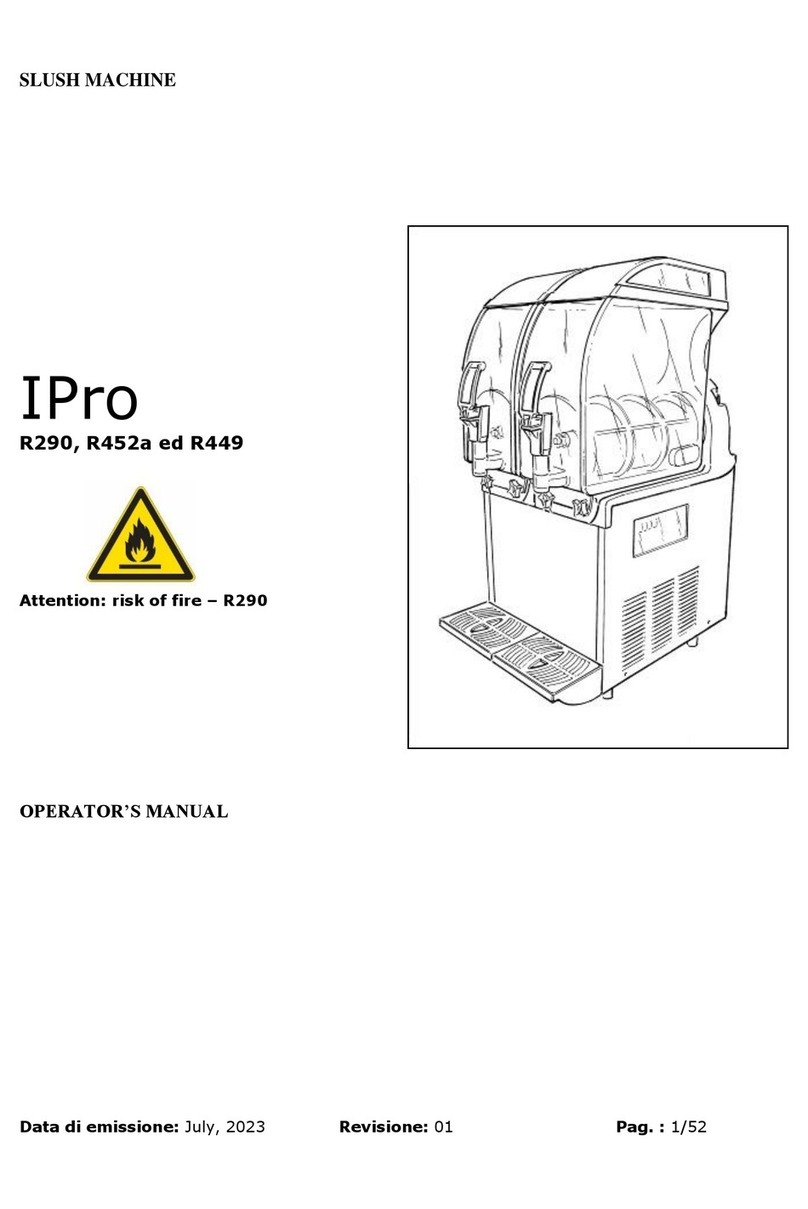
Electrolux
Electrolux IPro R452a Operator's manual
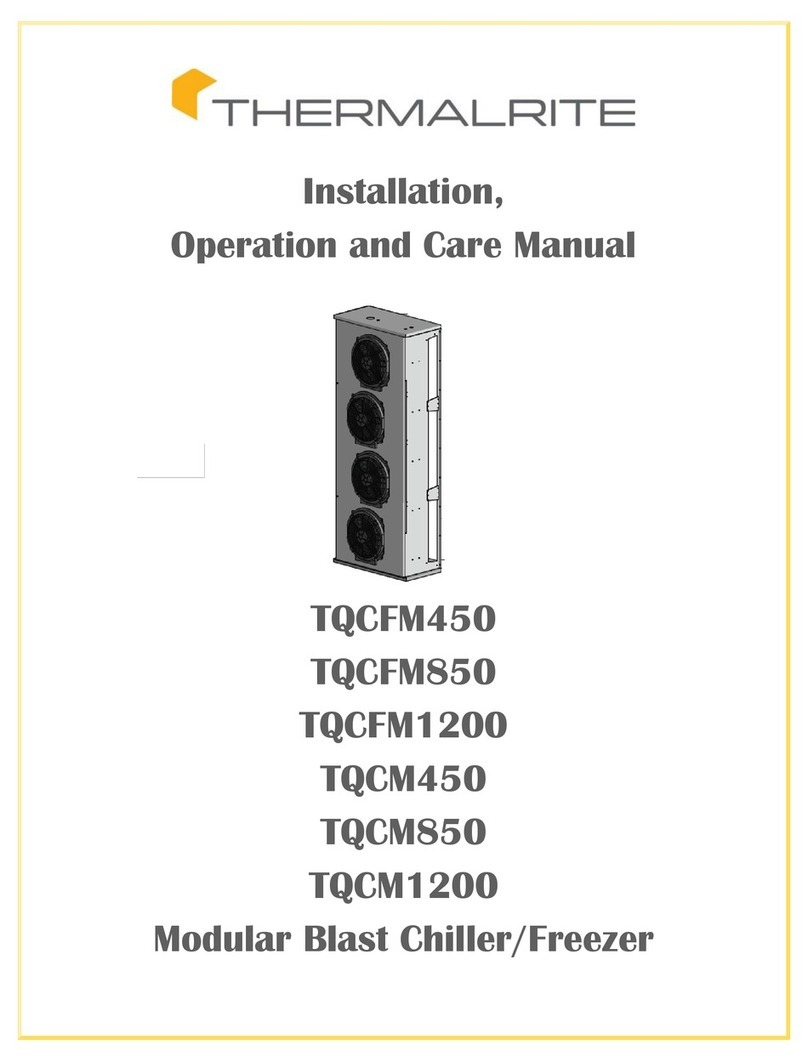
Everidge
Everidge Thermalrite TQCFM450 Installation, Operation and Care Manual
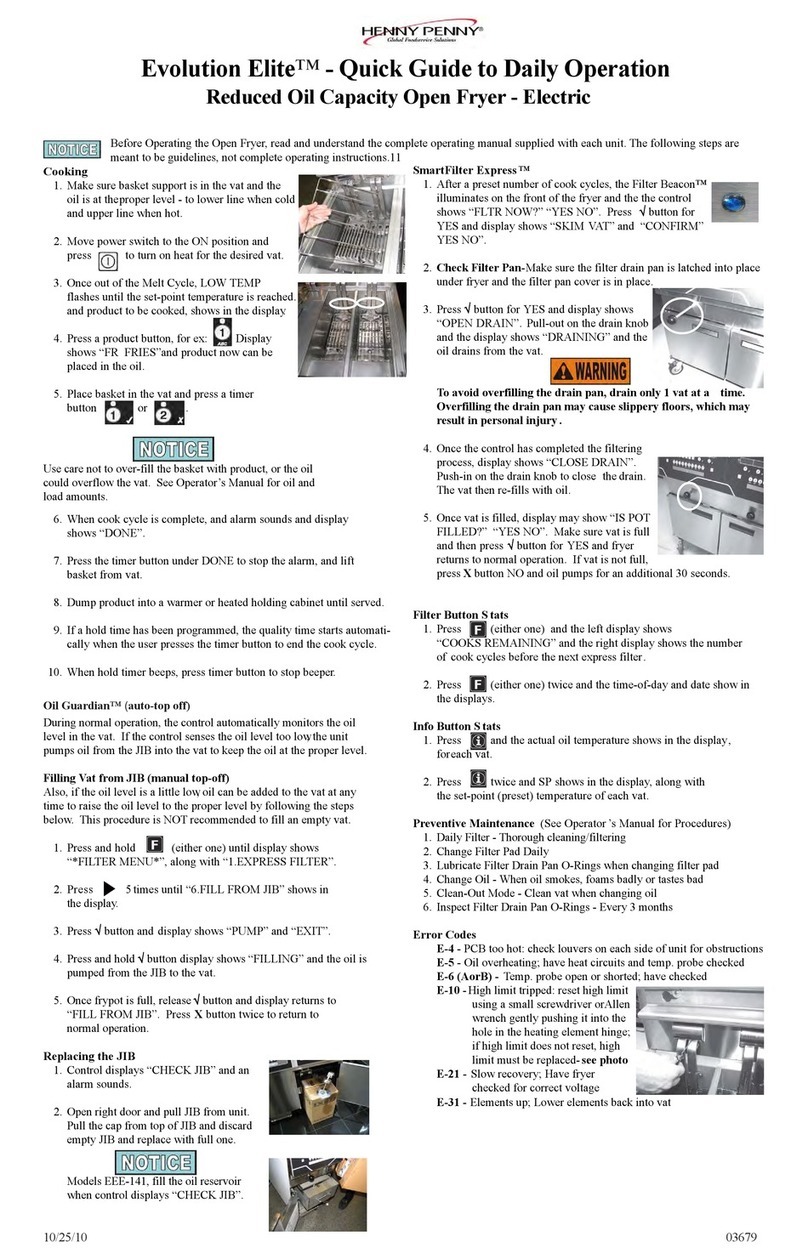
Henny Penny
Henny Penny Evolution Elite 14X quick guide
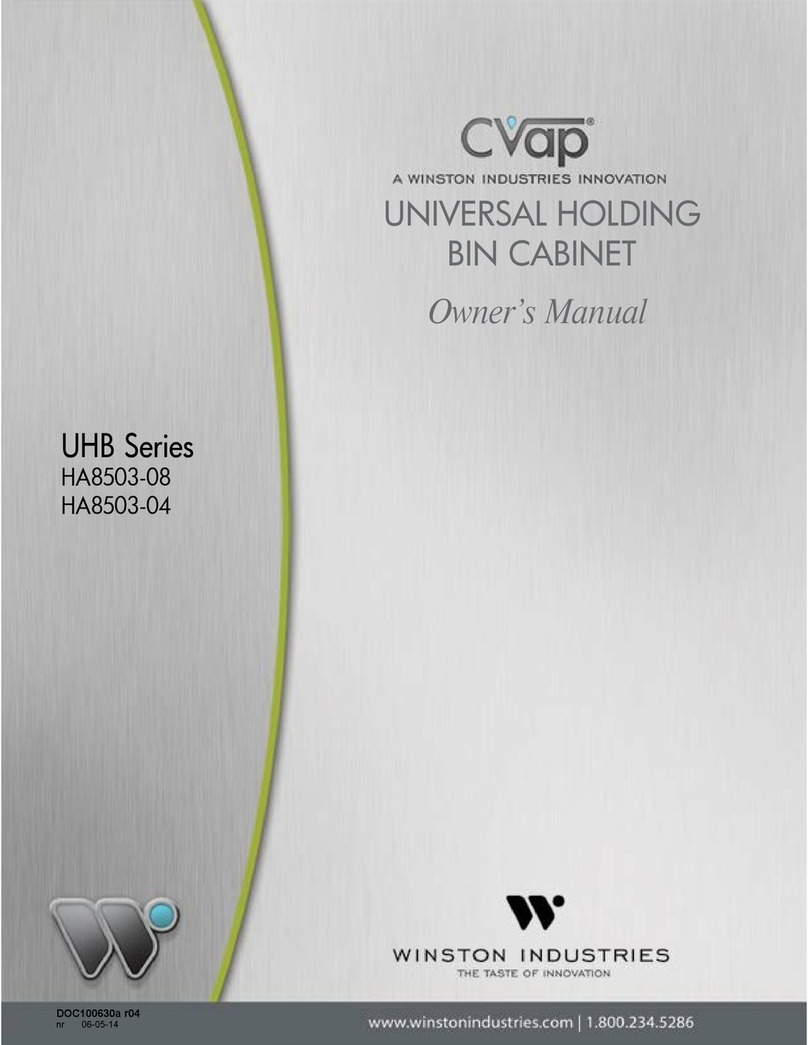
Winston Industries
Winston Industries Cvap UHB Series owner's manual
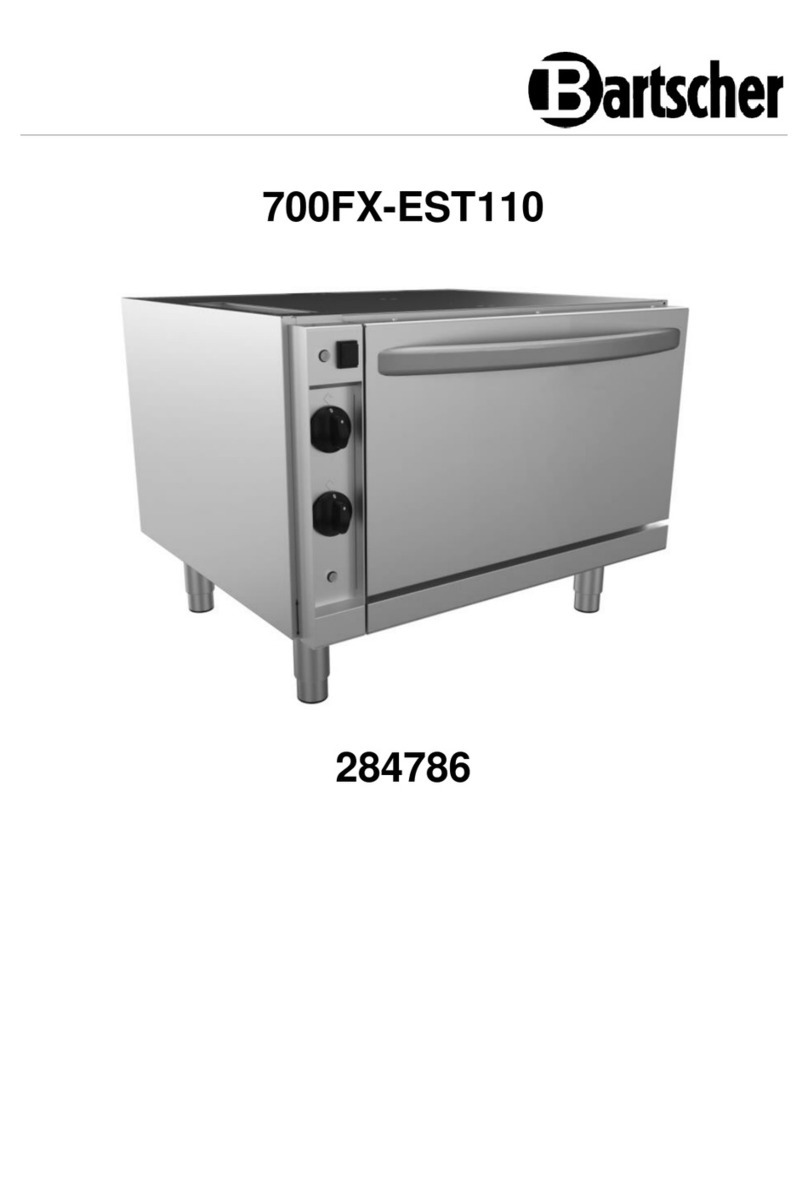
Bartscher
Bartscher 700FX-EST110 manual
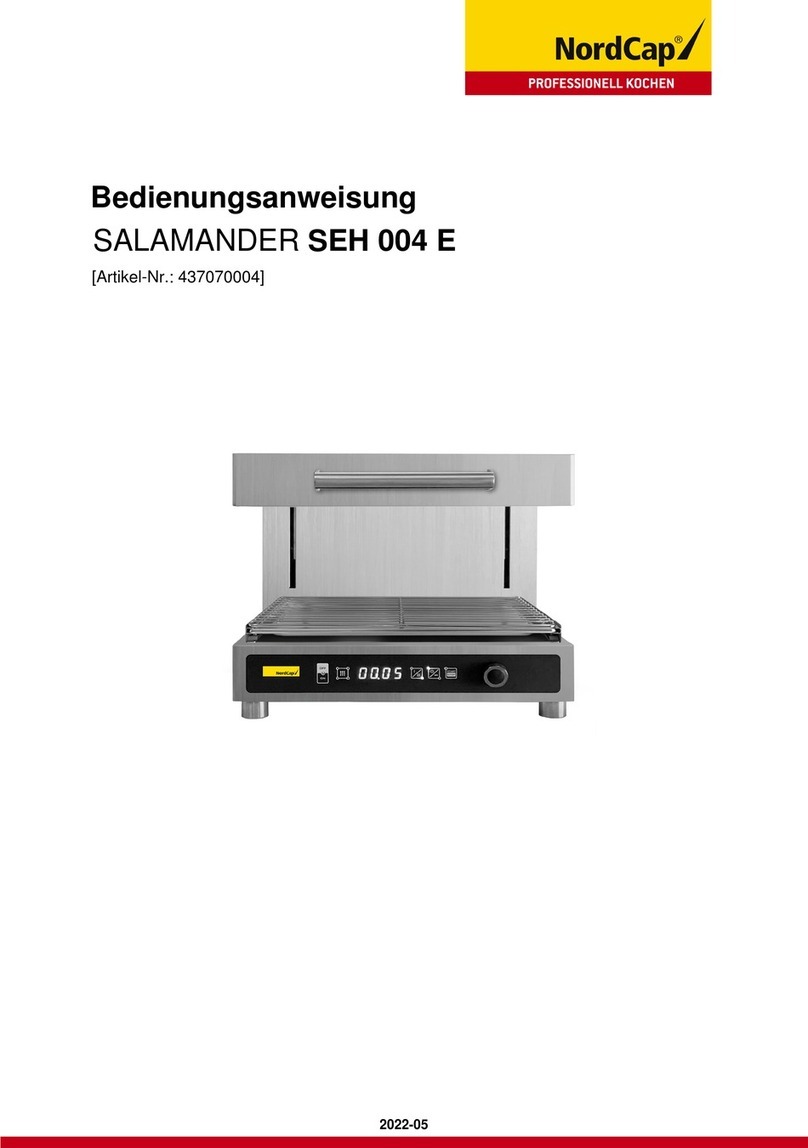
Nordcap
Nordcap SALAMANDRA SEH 004 E INSTALLATION AND USE BOOKLET
